|
Raserys posted:i know he's supposed to be the real person, but after looking through the ck2 title history for britannia, i can't imagine how annoying it must have been to work for maximus maximianus maximus
|
|
|
|

|
| # ? May 25, 2024 17:28 |
|
Chapter 57: A great day at the Gothic court! 1600-1624 In the early years of the 17th century, Gothia encountered both significant successes and surprise losses. Its failures would shake the foundations of the state, but the Gothic people still prospered. 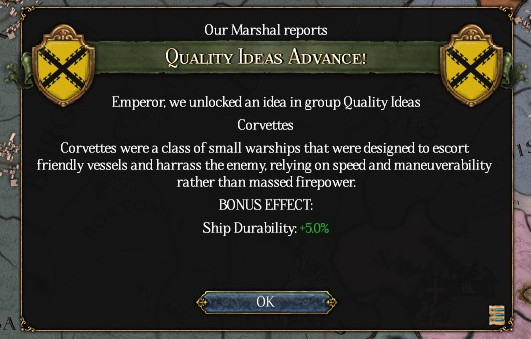 King-Emperor Tiuderic XI, being the son of a colonial, encouraged further Gothic colonization of the New World throughout his life. To that end, he became a promoter of maritime innovations, funding research into significant advances in shipbuilding such as early corvette designs. 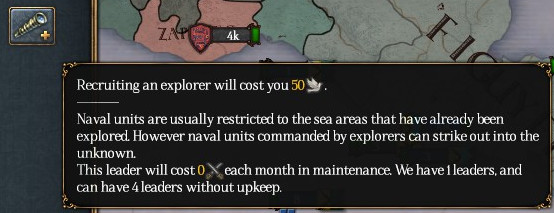  More than that, Tiuderic also patronized further exploration and colonization efforts, largely through a 'Royal Colonization Society' founded in 1601. The voyages of Gabrieu de Massava, who explored much of the Pacific during the 1610s and 1620s, were a product of the king's extensive funding of the Society and broader colonial efforts. 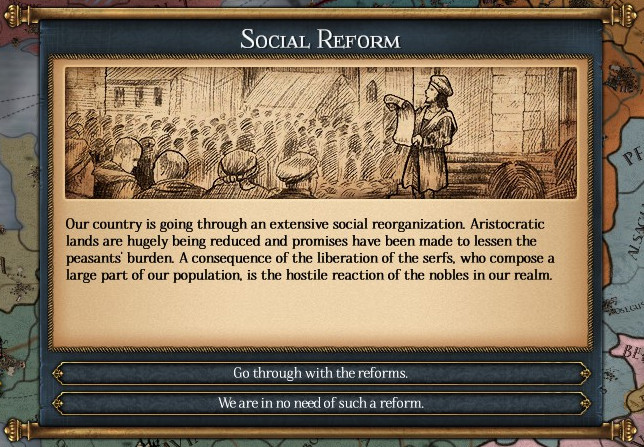 Gothic colonialism in some ways contributed to the weakening of the nobility in metropolitan Gothia; imports from the New World began competing with the products of country estates and also fueled the growth of manufacturing industries in Gothia's cities, contributing to a decline in agricultural profitability and increasing urbanization. These forces, among others, forced Gothia to gradually grant more rights to the peasantry during the later Renaissance. 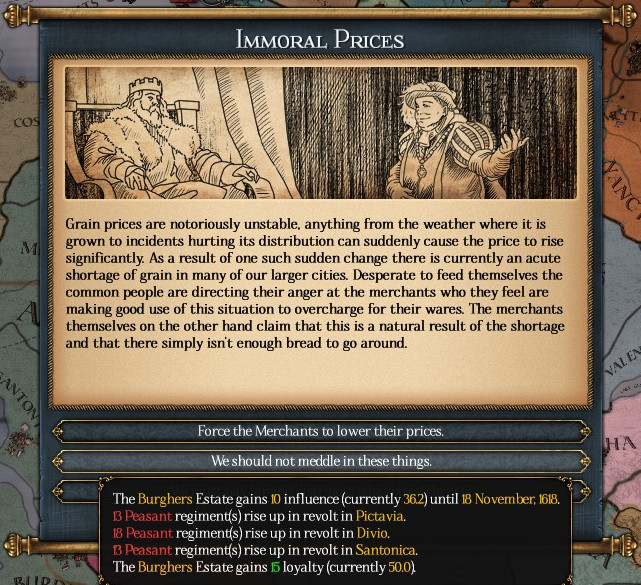 Not all such changes happened peacefully. Tiuderic, influenced by a new theory of 'freedom of commerce' floated by some intellectuals involved in the Royal Society's colonial work, experimented with a hands-off approach to a grain shortage in the autumn of 1603. The result was a string of peasant revolts across central Gothia. The rebels were suppressed in quick order, but Tiuderic still shied away from further experiments in market freedom during his reign. 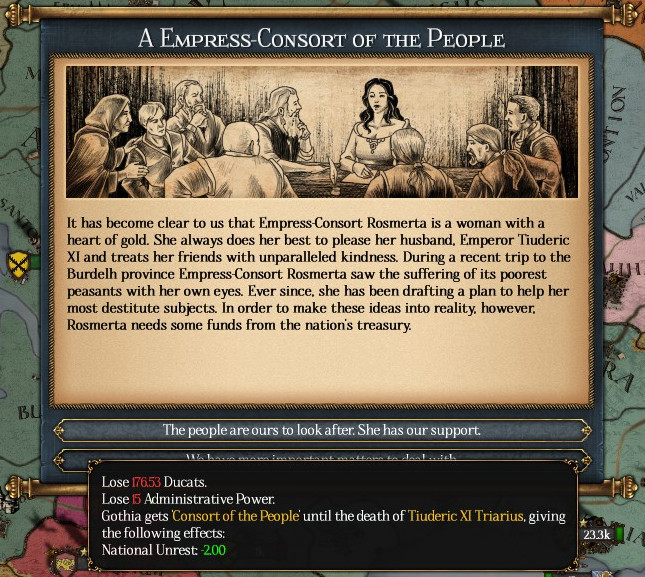 Even then, the tragedy of the grain revolts spurred on further progress, as Tiuderic XI's wife, Empress Rosmerta, saw the hardships of the peasantry firsthand after the suppression of the revolts, and vowed to find a way to help improve the lives of Gothia's poorest. Her efforts, while earnest and lauded at the time, were somewhat mixed; she established boarding schools for children of some of the poorest peasants, but only allowed students to attend on the condition that they live at the school and not return to their families for the duration of their education. She also sought to provide some income for the unemployed, and so promoted the establishment of church-administered work programs, which set their own standards for admittance and compensation. 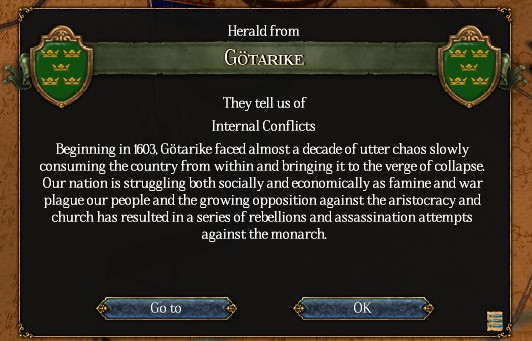 Some countries handled these changes worse than others. Götarike offers a striking contrast to Gothia, as the stubborn refusal of its government to accept changes in the social order led to a decade-long period of unrest and disorder in the early 17th century. Gothia's grain revolt was an exception to the general peacefulness of the realm then; in Götarike, however, such revolts were almost a yearly occurrence. 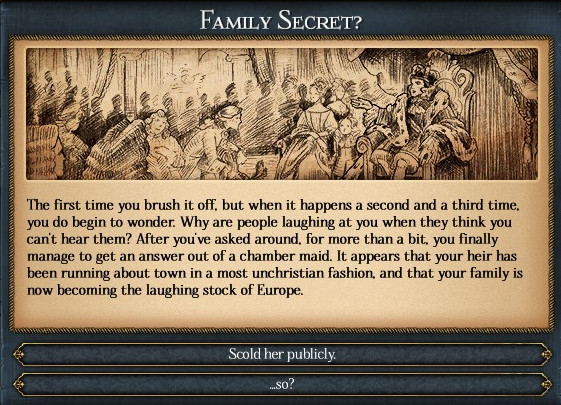 Despite the good fortune of Gothia during these years, the Triarian dynasty still faced scandals and criticism at home. Princess Berta, Tiuderic XI's only child and heir to the Gothic crown, was caught in dalliances with several suitors (sometimes, according to salacious rumors, with more than one at once), shocking the court and embarrassing the royal family to no end. The king tried to gently warn her off, but Berta continued to scandalize the capital. Eventually Tiuderic resorted to sending her to one of the dynasty's country estates under heavy guard, essentially imprisoning her. 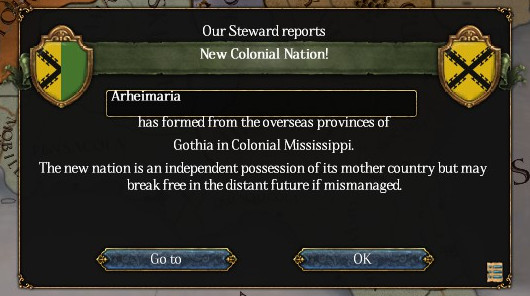 Tiuderic found solace in colonial affairs. By 1606, Gothia's lonely colony at the mouth of the Mississippi had turned into a chain of prosperous settlements spanning all the lands between New Gothia in Mexico and Victoria in Florida. When the colony was granted a royal charter by King Tiuderic, it completed a continuous line of mainland Gothic colonies that ran from Florida down along the Gulf of Mexico and across Panama to the very foothills of the Andes. To celebrate this Gothic achievement, Tiuderic turned to Gothic mythology and dubbed the Mississippian colony 'Arheimaria', after the legendary city of Arheimar. 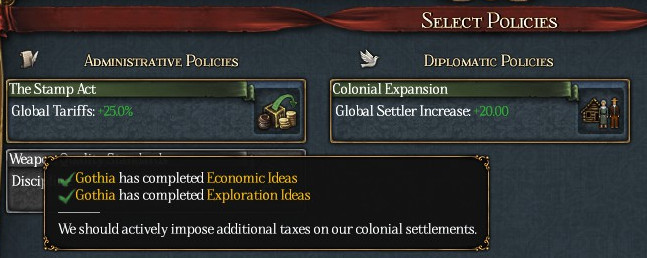 Geographic growth wasn't enough for the king or his court; they also sought to increase revenues from the lands they already had under their control. On May 4th, 1607, Gothia introduced its first stamp act, imposing duties on a wide range of items in the Gothic colonies. The taxes added significant amounts of cash to the royal coffers, but it also exacerbated tensions between the colonies and Gothia proper. 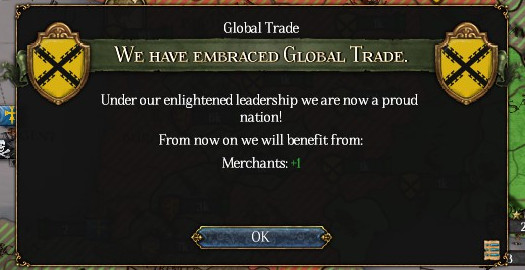 Such colonial mercantilism was simply part of the age, as far as the Gothic court was concerned. Control of global trade was an objective of most leading powers, both in Europe and abroad, and the government was using what tools it had at its disposal to advance its interests. 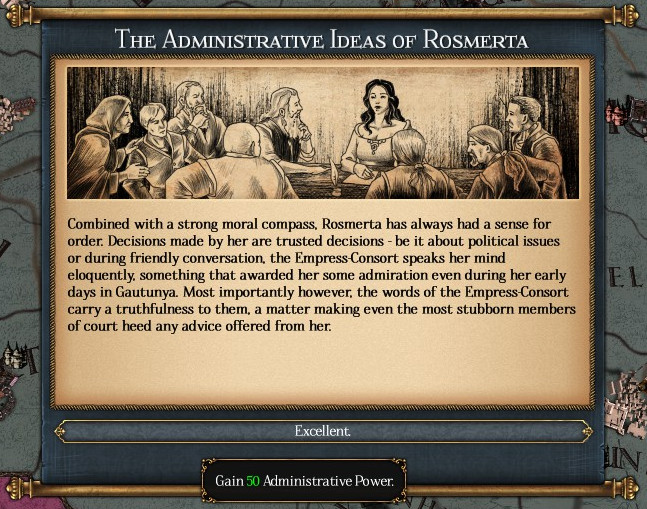 Inspired by these economic successes, Empress Rosmerta pushed for further reforms at home. In reaction to the overwhelming influx of paupers arriving at the charities she supported, the empress proposed establishing some sort of governing body that would determine the exact circumstances of a person's poverty; if the person was found able, they would be sent to a workhouse until a more proper livelihood could be found for them. Her proposals were not fully implemented, but in some cities, including the capital, several workhouses were established for the “idle poor”. 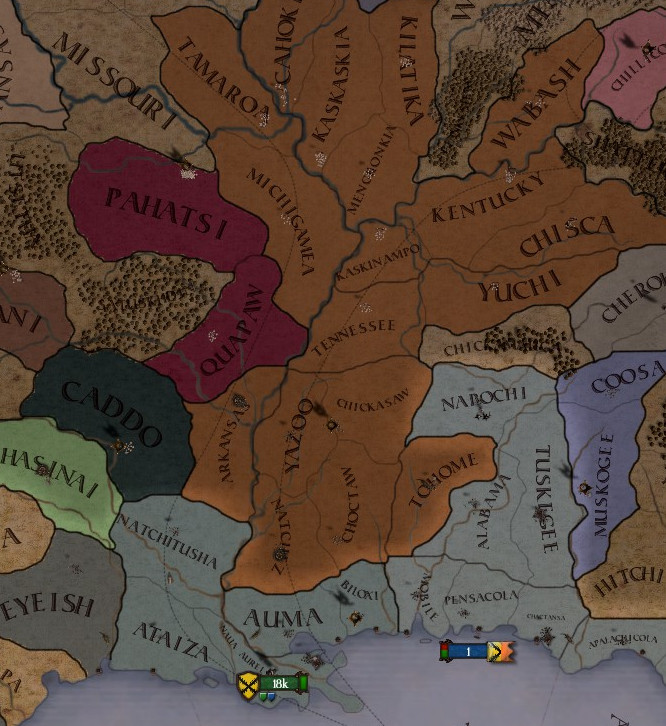 While Rosmerta focused on domestic affairs, Tiuderic's interested remains firmly fixed abroad. While the new colony of Arheimaria mostly hugged the cost, it controlled the mouth of the Mississippi River and so enjoyed a massive amount of influence over trade entering or leaving the river. However, very little of the Mississippi upriver of its mouth was under Arheimaria's control, and the Chickasaw Indians, having learned their lesson from their earlier war alongside the Creek against Gothia, had begun fortifying border settlements. Their two biggest forts in the area, Arkansas Post and Natchez, rested on key invading routes leading into Arheimaria. 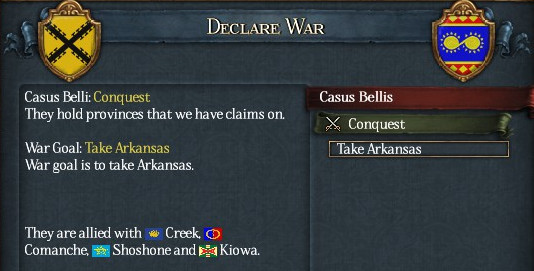 The Mississippi colony was one of the Royal Society and Tiuderic XI's first projects, and both the colonial faction and the king himself was anxious to see Arheimaria survive. And for that, Arkansas and Natchez had to be wrested away from the Chickasaw. 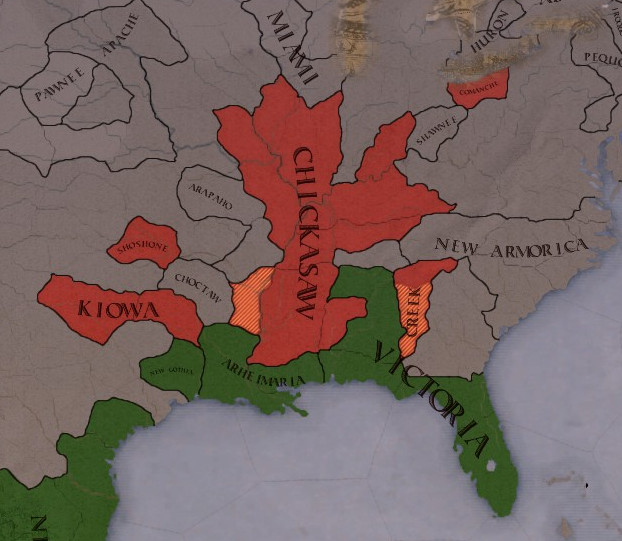 Aggressive moves against the Chickasaw in February of 1608 provoked a reaction both from the Chickasaw and from the Chickasaws' allies. Gothia was again at war with a huge swathe of the Mississippi Basin.  Surprisingly, the Goths enjoyed some significant gains early on in the war. Although Chickasaws had been constructing considerable fortifications at Natchez, they hadn't actually manned them with a garrison when the war broke. The Natchez fort fell after just a month besieged. 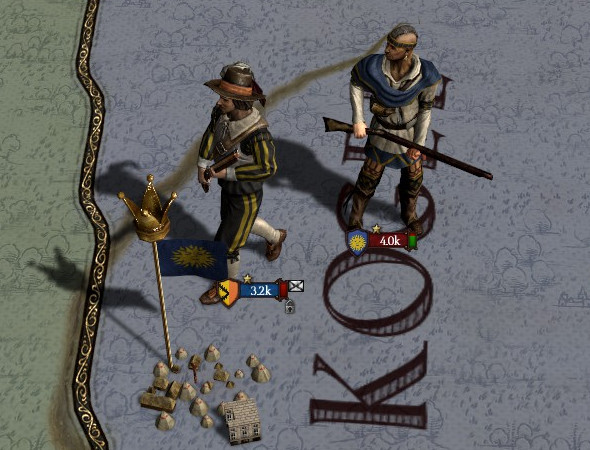 While the main Gothic army focused on taking the Chickasaw forts as quickly as possible, Gothic colonial militias also attempted to win massive gains for themselves. Their initial efforts fell flat on their faces, however. A Victorian army that marched into Creek territory on August 26th, 1608 was soundly defeated by Creek soldiers, and Kiowa cavalry harried frontier settlements in New Gothia until Gothia emissaries concluded a separate peace with them during winter of that same year. 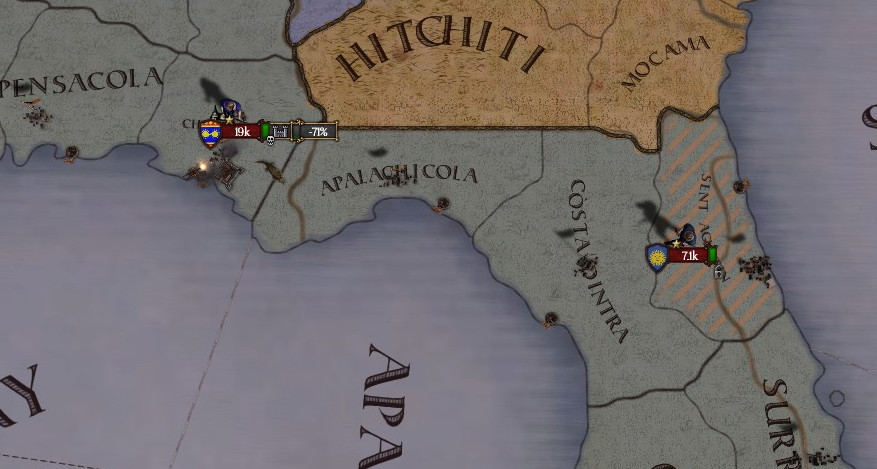 Like what had happened in the Creek war years prior, the Victorian colonial troops were collapsing at the first sign of an offensive. While the Gothic army got tied down besieging Arkansas (which unlike Natchez was garrisoned), the Victorians were beaten time and time again. By the beginning of 1609, Chickasaw and Creek troops were again running freely across Victoria, and again the Creek managed to seize Tiuderic's father's hometown of Sent Agustin. 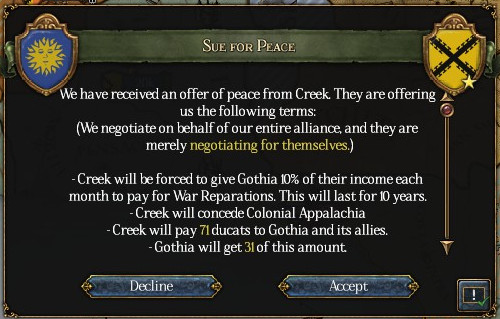 The Victorians' collapse was so complete that it drew Creek defensive forces out of their home territories and deep into Florida. This, ironically, enabled the Creek to be conquered by colonial forces from New Gothia, which managed to quickly take all of the Creek home territories while their armies were roving across Florida. 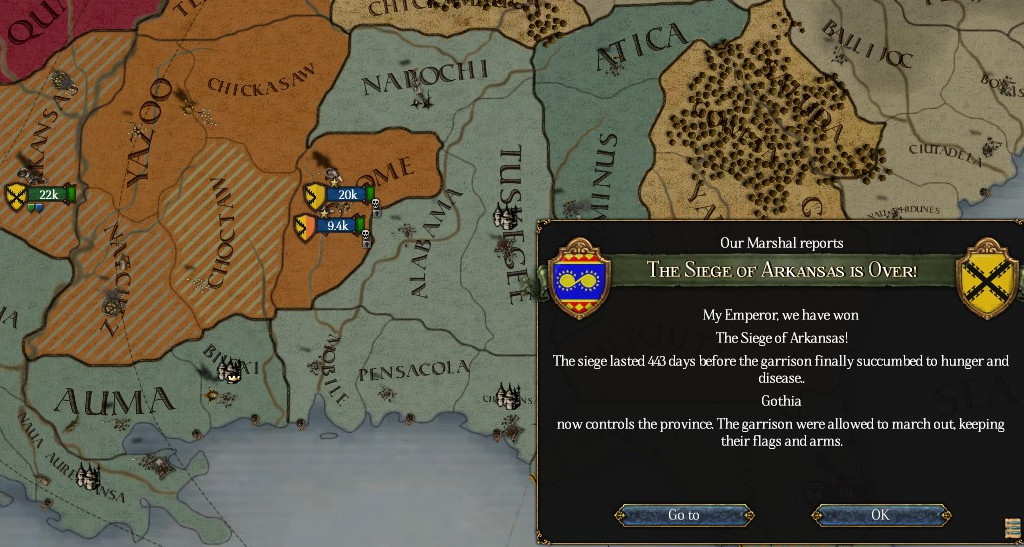 A month after the Creek surrendered, Arkansas finally fell, opening the way to march deep within Chickasaw territory. 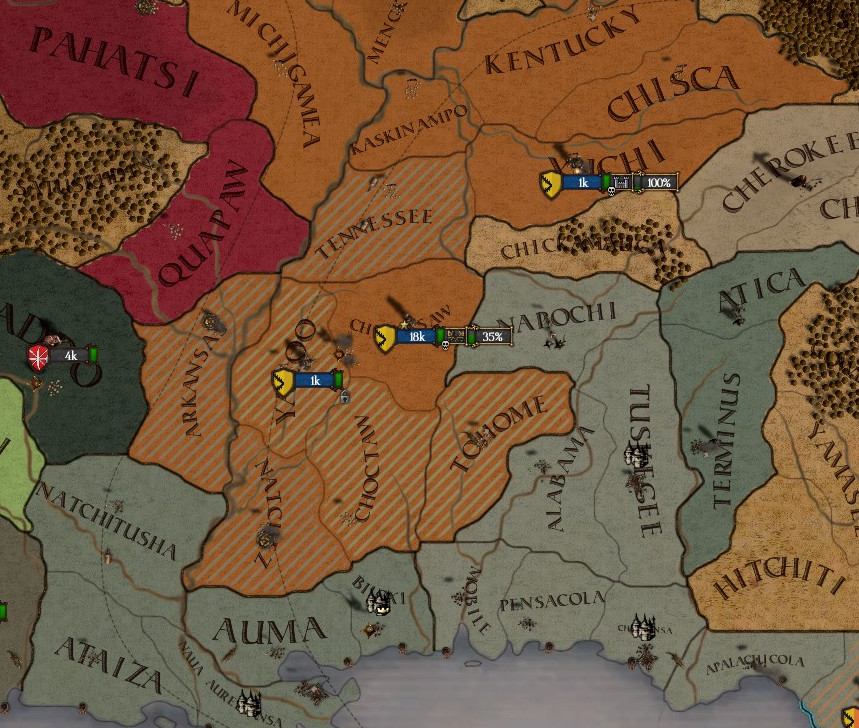 These incursions were left to New Gothic troops, which had shown competency in fighting. They moved quickly to occupy further Chickasaw territories, and reached the Ohio River by October of 1609. 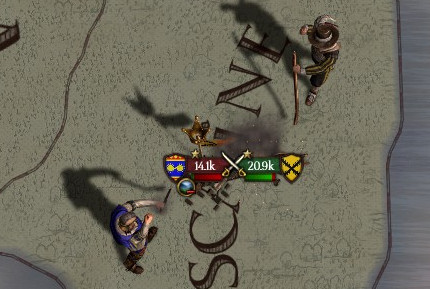 The Gothic army, meanwhile, removed itself from Chickasaw lands and pursued the Chickasaws in Florida down all the way to the southern tip of the peninsula, where they were defeated in the November 4th Battle of Biscaïne. 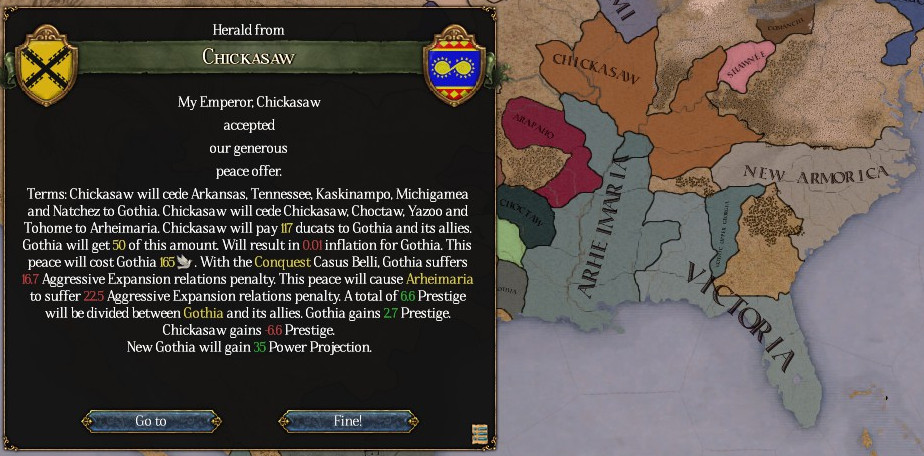 With the attack into Victoria checked and colonial troops encountering no opposition in their incursions, the Chickasaw finally surrendered on February 3rd, 1610. Along with the key forts at Arkansas and Natchez, the Chickasaw were compelled to cede all lands up to the Ohio-Tennessee river system on the east bank of the Mississippi, and all lands up to the Missouri River on the west bank. 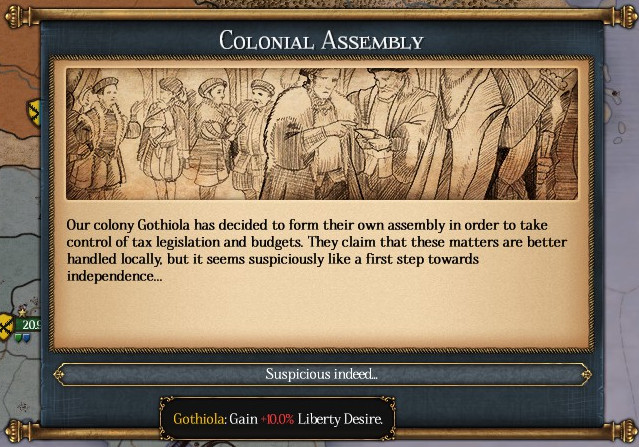 To Tiuderic's surprise, despite the Crown leading victorious wars of expansion for the benefit of Gothia's colonies, and despite being the son of a colonial himself, the 1610s saw a series of moves by colonies against Gothic centralization, with Caribbean Gothiola, the Mexican New Gothia colony and Floridian Victoria all establishing their own colonial assemblies.  Seeking to successfully assert his authority somewhere, Tiuderic's attention drifted back to Europe. While the Goths had been focused on securing the Mississippi, the Duchy of Aquitania, which had been so recently saved by Gothic intervention, annexed the last remnants of Septimania and violated imperial integrity. Tiuderic issued a sharp rebuke to the duchy, demanding the restoration of Septimania and an end to annexations. 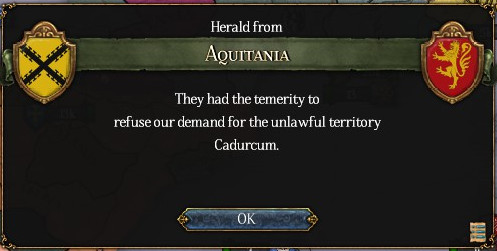 Aquitania refused. 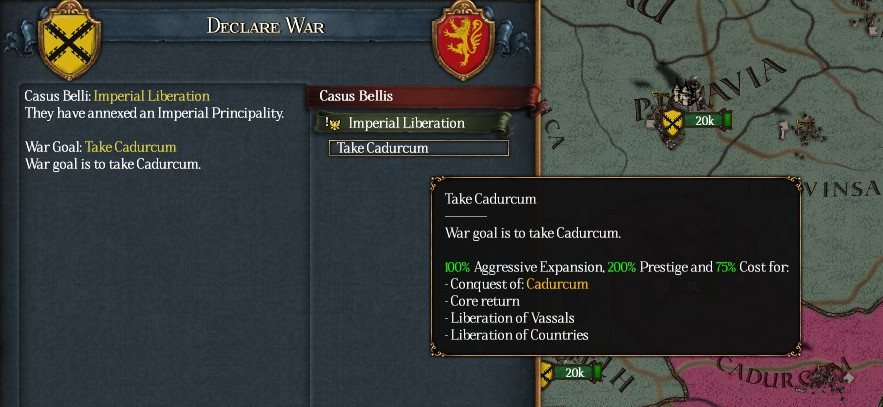 Incensed, Tiuderic declared war on the Aquitanians on March 25th, 1612. 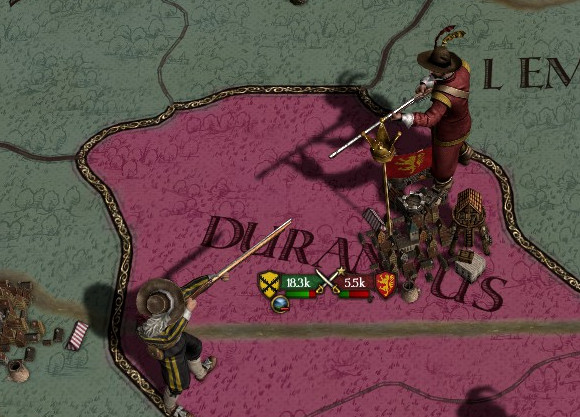 Unlke the Chickasaw, Aquitania had no allies to distract Gothic armies with, and was quickly overwhelmed by Gothic troops. 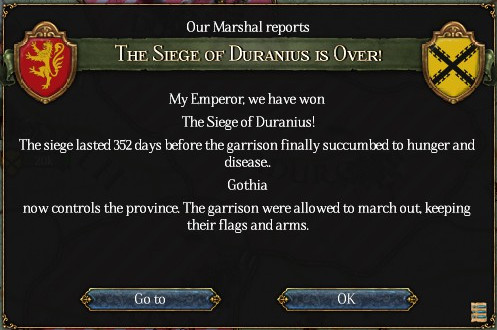 The last of Aquitania's strongholds fell to the Goths a little more than a month after the war began, on April 7th, 1613. 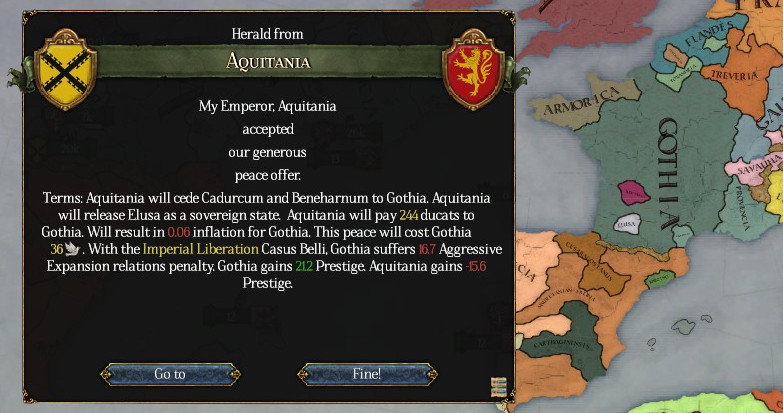 Frustrated by the annexations and reverse-annexations of the Gallic principalities, Tiuderic's peace imposed upon Aquitania reduced it to one province, with one other province released as the reforged Duchy of Elusa. Aquitania's other territories were taken by Gothia, to prevent Aquitania from annexing Elusa and Elusa from annexing Aquitania in the future. 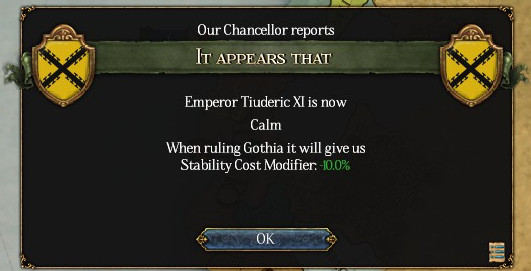 After that last fit of pique, Tiuderic XI settled down, and became a much calmer man for the rest of his reign. 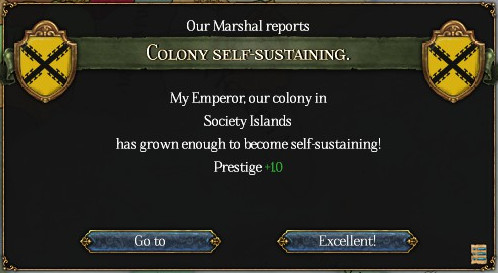 The king turned back to matters of colonization and innovation. Gothia expanded further, settling a South Pacific archipelago dubbed the 'Society Islands' after the Royal Colonization Society.  The sciences also boomed, with discoveries being exchanged through scientific organizations based upon the same model as the Royal Society.  Tiuderic XI, being a free thinker, relished the new geographic and scientific discoveries, and actively encouraged innovation in the Gothic sciences. While this spirit of innovation did not pay off for him and Gothia immediately, it left an indelible mark on the Gothic national character. 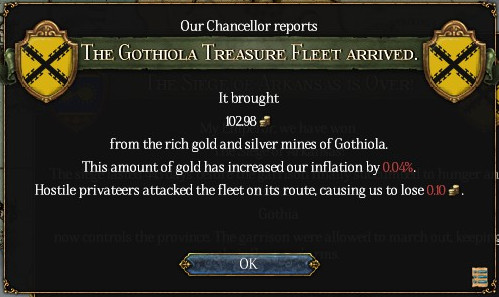 One of the most interesting developments during this period of peace and research was an accidental discovery at the Royal Mint. Regular imports of New World gold and silver prompted the Mint to establish a center for metal processing and assaying. Silver nitrate was a common byproduct of the Mint's gold assaying process, and in 1616 a circle of scientifically curious goldsmiths began using the Mint's excess silver nitrate in their own personal experiments. One early product of this was the synthesis of silver chloride, a powdery material, which the smiths quickly discovered was very sensitive to light after a jar of it was left by a window. Surprising the smiths, the jar only changed color where the substance had been directly exposed to light- portions of the compound covered by the shadow of the window frame hadn't changed shade at all, while light-exposed silver chloride darkened quickly. The smiths soon took to bringing the “silver jars”, as they called them, to parties, where they would wow guests with the reactions of the light-sensitive material. Some minor experiments continued, but for the most part, the smiths focused on their work in the Mint.  While the smiths' experiments with silver nitrate and derivatives would have long-lasting ramifications later on, what received much more attention at the time was the 1616-17 voyage of Gabrieu de Massava. Setting sail from the Azores on June 30th, 1616, Massava sailed southwards, safely rounded Patagonia, arrived at the Society Islands without major mishap, and then continued to sail westward towards the fabled Terra Australis. He met Moluccan colonists already establishing small colonies on Australia's coast, and it was there that Massava himself died after a fatal misunderstanding between the Gothic crew and the local Moluccans. One of Massava's ships attempted to sail back towards the Americas, while the other forged westward. Lusitanian colonists at the Cape of Good Hope were surprised by the arrival of a Gothic ship coming from the east, but it arrived and departed before they could decisively act against the ship. Finally, it turned north, and the surviving crew returned to Gothia on June 1st, 1617. 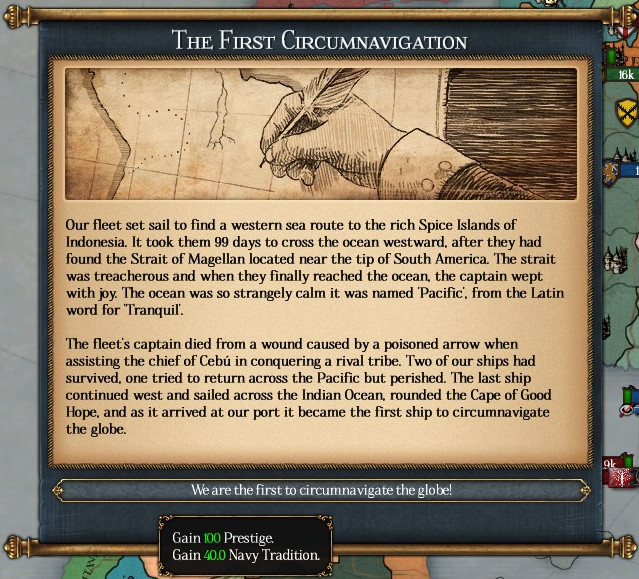 The speed of Massava's voyage was greatly helped by the decades of earlier explorations done by both Massava himself and prior adventurers. The Straits of Magellan had been first surveyed by a Lusitanian explorer over a century earlier, and much of the Americas' Pacific coastline had already been discovered by both sea-going explorers and land-bound gold-hungry conquistadors. With much of the territory already known, Massava's only big gambles were regarding some of the currents in and around the East Indies, and whether his ships were sturdy enough to actually make it all the way around the globe. 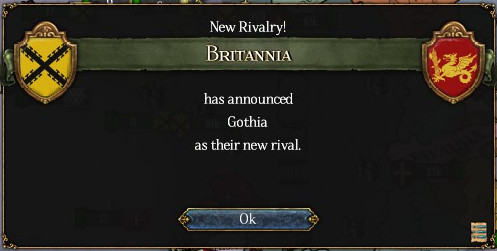 Perhaps worried by Gothia's growing prestige, Britannia began taking a ever-more hostile stance towards the Goths. Belligerent diplomacy and deteriorating trade relations in the 1610s and 1620s almost plunged Gothia and Britannia into war on more than one occasion, but every time, diplomacy was able to soothe hotheads before armed conflict could begin. 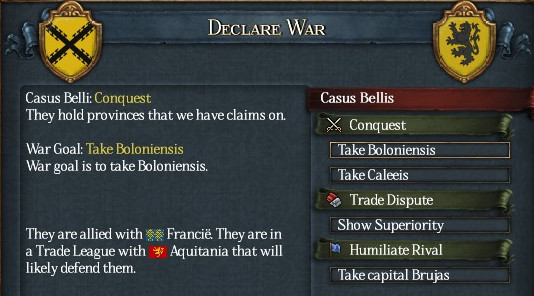 The war scares prompted the Gothic government to consider what to do in the event of diplomacy failing. Combined with its colonies' booming trade, it was decided that Gothia needed more ports- and that meant annexing neighboring territories. Armorica in the 1610s had built an impressive web of defensive alliances with Gothia's other neighbors, but the Republic of Flandés, which sat just to Gothia's northeast, was only in an alliance with the Franks and the remains of Aquitania. The Franks had recently lost a war, and were considered little threat to the Gothic military, and so the Flemish territories of Boloniensis and Caleeis were targeted for expansion. 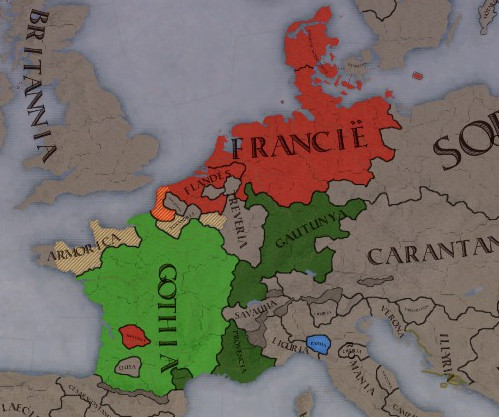 War was declared on March 17th, 1619, and the Flemish immediately called in the Franks and Aquitania for help. The Goths, meanwhile, called in their allies Gautunya and Provencia. 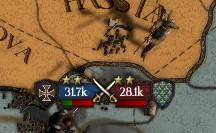 The Gothonians actually fought in the first battle of the war, attacking and defeating a Frankish force which had crossed into Gautunyan territories on the east side of the Rhine. 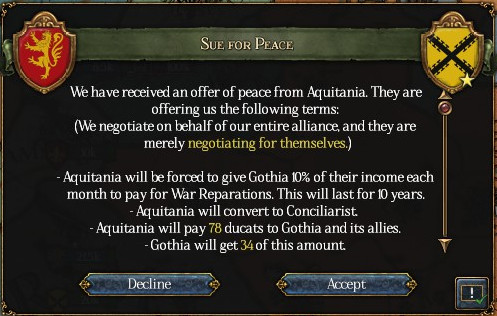 The Aquitanians failed to mount a stout resistance to the Goths, and were quickly defeated by the royal army. Rather than suffer another humiliating occupation, the Aquitanians sued for peace, and quit the war early on. 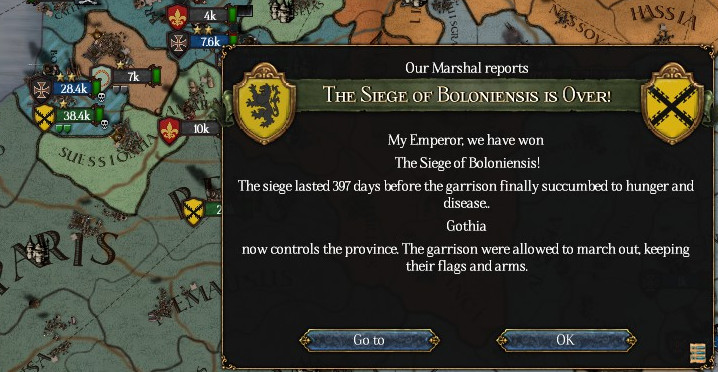 After a year's struggle, the rest of the Gothic forces managed to capture the fortress town of Bolonha itself on April 28th, 1620. Caleeis itself fell not much later, in June of that same year. 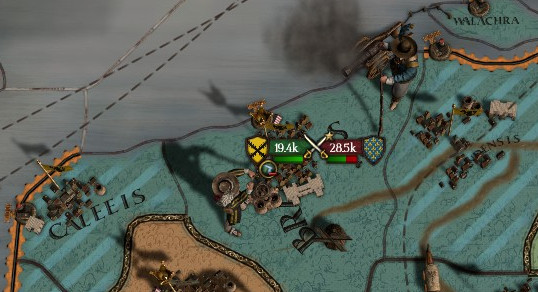 Despite the occupation of its war goals, Gothia suffered a significant setback in the conflict when a Frankish force mounted a surprise attack on Brujas, driving one of the Gothic field armies back into Gothia proper. 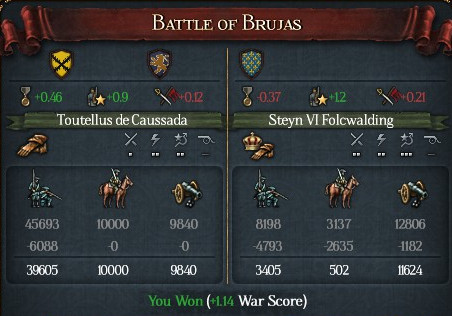 Gothic gains in southern Flandés were only saved with the arrival of a hastily-assembled relief force, made by combining the remnants of two armies together with a complement of fresh mercenary recruits. The new force outnumbered the exhausted Frankish army by more than two to one, and was able to beat the Franks at a second Battle of Brujas in October of 1920. 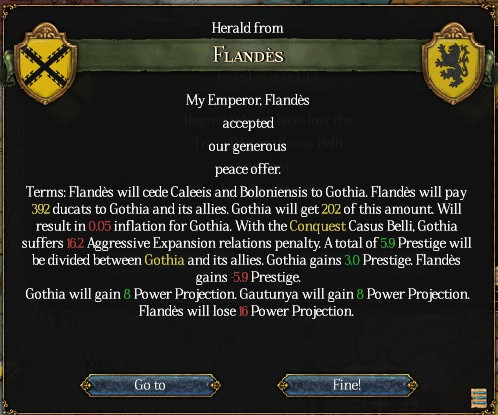 The relief force was enough to break the Flemish-Frankish alliance, and Flandés finally accepted Gothic demands on June 16th, 1622, giving Gothia two new ports facing Britannia. 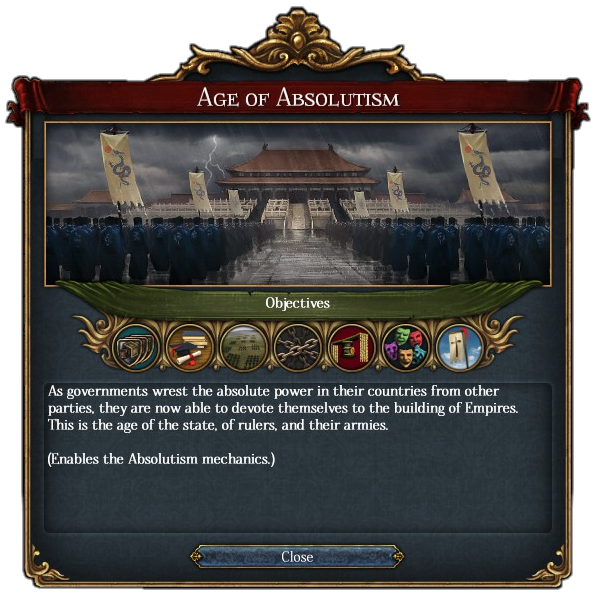 Under Tiuderic XI, the Gothic realm had increased its holdings in Europe and abroad. Trade expanded, and the state was able to more and more effectively suppress the old feudal order. 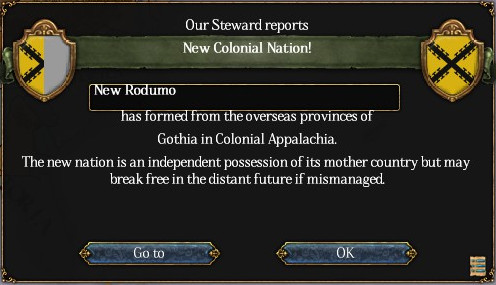 Abroad, the Gothic colonial empire continued to expand, particularly in the Mississippian and Appalachian regions. Arheimaria and New Rodumo (established in 1624), respectively, became the latest jewels in the Gothic crown. 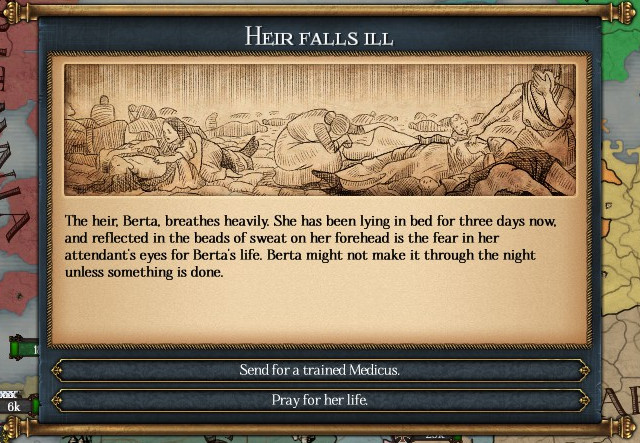 All the prosperity the Goths could muster could not solve one very personal problem for the kingdom. Tiuderic had only fathered one child, Princess Berta, and after several indiscretions in her youth he had exiled her to the crown's country estates and away from the capital. There, Berta had languished, never marrying and losing much of her youthful charm. Even worse, her health began to decline, and in the spring of 1624 she fell into a coma. 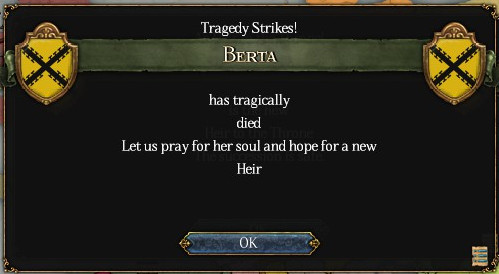 On July 9th, 1624, Princess Berta passed away. 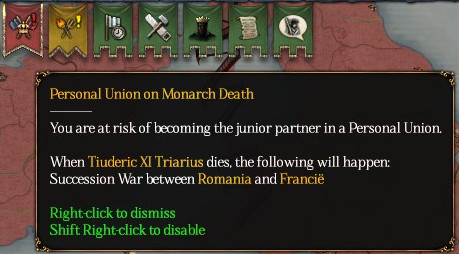 King Tiuderic XI had no other children of his own, but through several marriages in the 16th and 17th centuries, the Gothic Triarians had many close relations across Europe with plausible claims to the crown. One was Constantin Triarius, King of Romania, and the other was Steyn VI Folcwalding, King of the Franks. Both coveted the throne of Gothia; if Tiuderic XI followed his daughter to the grave without producing another heir, the two kingdoms would surely come to blows over the fate of Gothia. 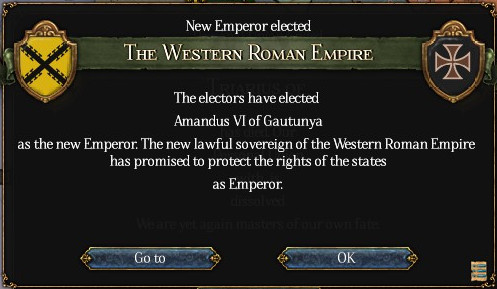 On December 14th, 1624, that is exactly what happened. Tiuderic XI was already an old man, and the death of his daughter had driven him into a deep depression. The king died in his bedroom shortly before Christmas. The court doctor officially ascribed his death to a “broken heart”, but rumors immediately began spreading that he had been murdered by the Franks or Romanians, or even that he'd committed suicide. 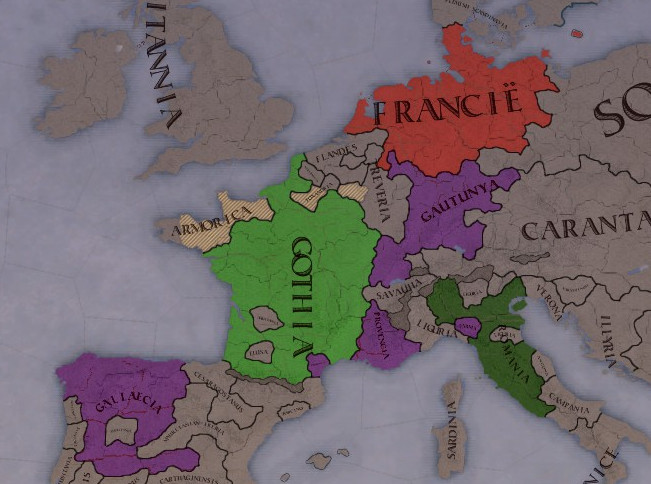 Regardless of the causes, the result was a succession crisis. The Romanians were the first to react, with Constantin Triarius proclaiming himself “Regent of Gothia” until the crisis was resolved. King Steyn, furious at Constantin's proclamation, immediately began preparing for an invasion. The Gothic court, taking the Frankish threat seriously, quickly moved to accept Constantin's new regency. And so, Gothia lost its independence. World map, 1624: With labels: 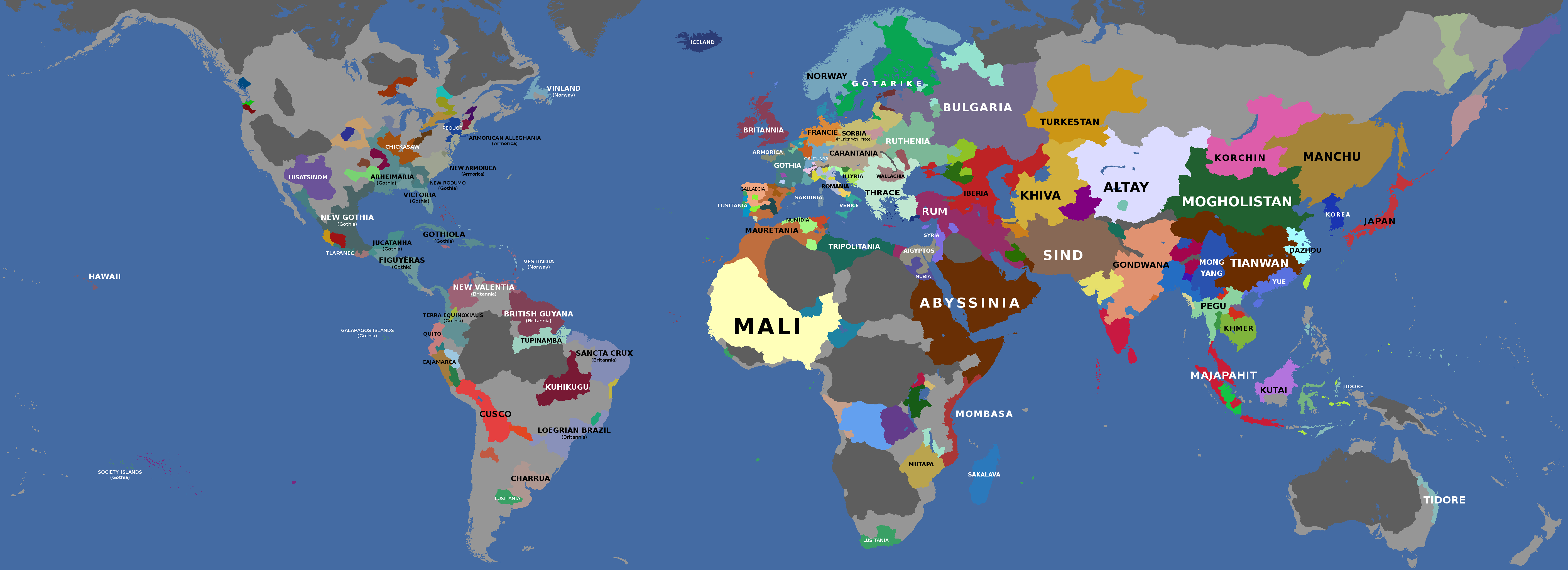 Without labels: 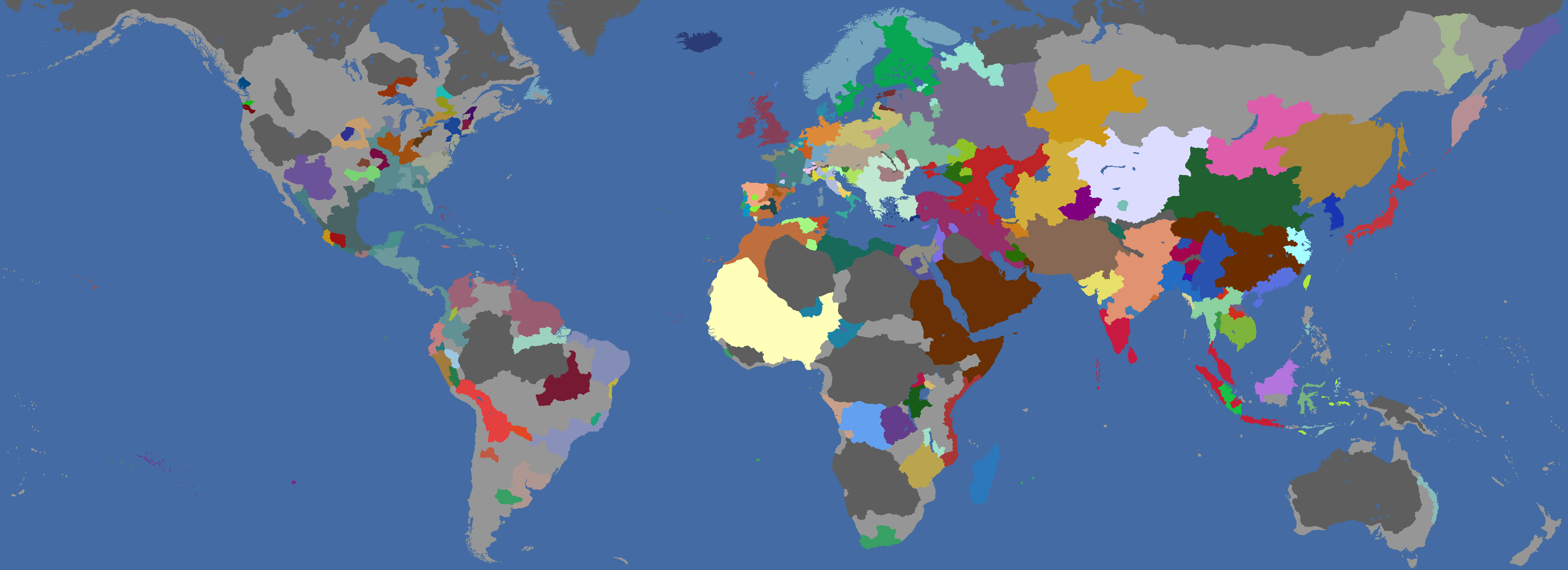
|
|
|
|
Accursed Franks! What can one of those savages know about Gothia? How dare their king presume to rule over us, his betters! He has a talent for losing wars, though, so I think we have little to fear. Ofaloaf, is Tidore in the Pacific ours too?
|
|
|
|
Tidore is Tidore. They've gleefully started colonizing a few unclaimed islands in the East Indies as well.
|
|
|
|
The color and name have a certain Gothian flavor, though, yes? We probably won't have to change the name when we conquer them! Our Mississippi colony sure grew though, Jesus. I suppose Floridans are the worst in every timeline
|
|
|
|
Starting to wonder what the colonial cultures that are developing are like. Are the economies plantation based? What are the cultural differences between Brithenig speaking colonies and Gautes speaking colonies? What motivates the colonists from each nation to go to the New World? Are Colonial Missions commonplace, especially given that the largest colonial powers are Concilliarist and Reformed respectively? How are relations with the Native Americans? Also, could you post a religious map?
|
|
|
|
HailedUser posted:Starting to wonder what the colonial cultures that are developing are like. Gothic colonists are probably operating under a Virginia Company approach, promising to work the land (that the natives have been driven off of after being provoked into war or revolt) in return for extensive land grants and privileges, depending on when they came over. Although metropolitan Gothia has done pretty dang well for itself, wars are still fought on its territory all the time, so I could see people also wanting to leave just to get away from all that (and then moving to Florida and getting conquered by the Creek). quote:How are relations with the Native Americans? quote:Also, could you post a religious map?  Judaism kinda died out as a Turkic steppe thing. It's only predominant around Samarkand and a bit of Persia now. :/ And for that matter, Manichaeism has done poorly too. Zoroastrianism's reasserted itself in most of Persia, and there's only three countries that are still Manichee: Turkestan, Mogholistan, and a little two-province minor in Vietnam.
|
|
|
|
Wait, is Romania Reformed? Our new king is a heretic!
|
|
|
|
Who owns Easter Island? And is that Ternate in control of Taiwan?
|
|
|
|
Ofaloaf posted:. It's nice to see someone other than the Brits and Goth finally getting some colonies going.
|
|
|
|
Just once I'd like to see Indigenous Australians with their own empire in a Pdox Mega-LP.
|
|
|
|
It seems... wrong that the new world Gothic colonies should be divided into Gothia and Armorica. One can only pray that our Romanian overlords are attentive to Gothic interests
|
|
|
|
Coward posted:Just once I'd like to see Indigenous Australians with their own empire in a Pdox Mega-LP. Be the change you want to see in the world
|
|
|
|
Coward posted:Just once I'd like to see Indigenous Australians with their own empire in a Pdox Mega-LP. I think this happened in the Hansa Mega LP. Kinda.
|
|
|
|
I'd like to see a cultural map of Europe, Germania has been rather quiet so I'm cruious what's going on there what with Gautunya having expanded there big time.Coward posted:Just once I'd like to see Indigenous Australians with their own empire in a Pdox Mega-LP. For what it's worth, I doubt Tidore could realistically exert significant influence over a colonial territory as large as what they have without a more than significant inclusion of indigenous peoples in the administration.
|
|
|
|
Ofaloaf posted:
Well that's all rather disappointing. Also the fact that Gnostic looks to have really petered out in the east.  Bulgaria has gotten huge. Ikasuhito fucked around with this message at 12:12 on Aug 5, 2017 |
|
|
|
We should really consider putting some taxes on the colonies to make them pay for our rather large armies we have to defend them from the Barbarians.
|
|
|
|
Pass some Sugar Acts, Stamp Acts, Tea Acts, all the Acts.
|
|
|
|
|
Yeah what can go wrong anyway?
|
|
|
|
Crowsbeak posted:We should really consider putting some taxes on the colonies to make them pay for our rather large armies we have to defend them from the Barbarians. Also we should make the colonists house our soldiers because reasons.
|
|
|
|
Funky Valentine posted:Also we should make the colonists house our soldiers because reasons. Also do we allow monks to exist I am not sure, but if there are any that we could say are involved to much in educating the upperclases and merchants about strange ideas and have some economic influence we should suppress them and seize their properties. Then either sell them or make them of use to the state, I know we can run them jsut as well and this wouldn't in anyway damage our economy. I am sure doing so wouldn't lead to their former pupils becoming disenchanted with our entire system, and even rejecting religion for some sort of weird cult involving individual reason. (OOC I wonder if we could even go with a break like Portugals and Brazisl) Crowsbeak fucked around with this message at 23:11 on Aug 19, 2017 |
|
|
|
Chapter 58: The Union of Rome 1624-1645 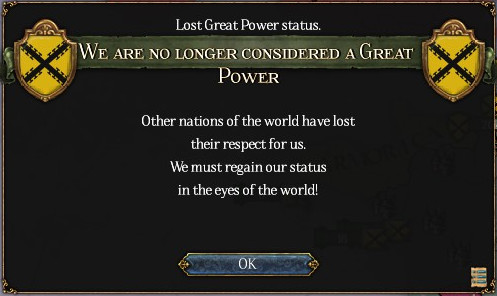 The death of Tiuderic XII left the kingdom of Gothia in a succession crisis. Lacking a direct heir, the kings of both Romania and Francië claimed the Gothic crown for themselves, and plunged their realms and Gothia into war. Although the Goths were able to retain a separate identity and a separate government, its union with a foreign crown marked a low point in the realm's fortunes. 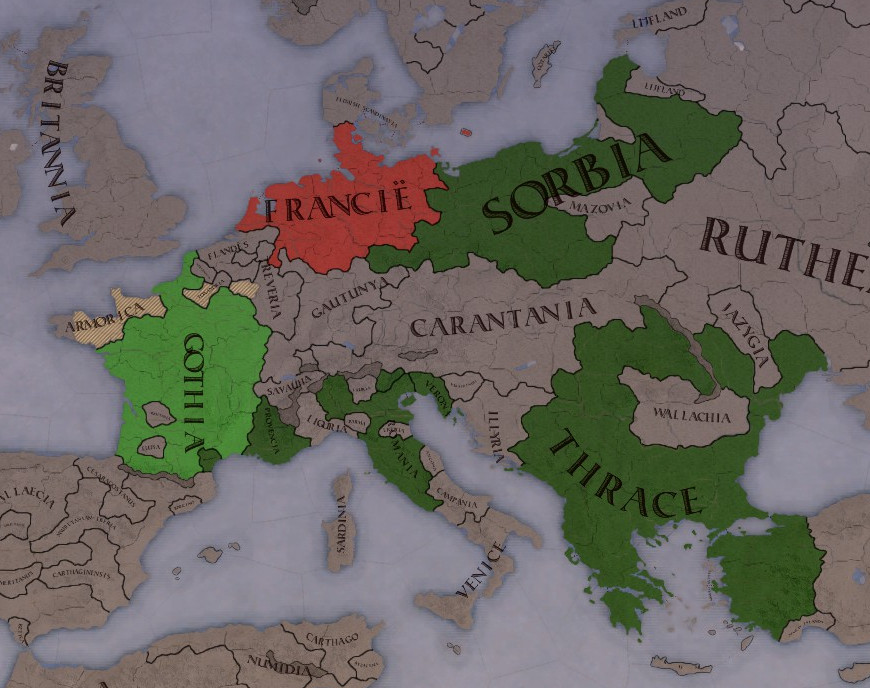 Romania made the first move, securing the support of the Gothic Senate before the Frankish delegation could arrive at the Gothic capital. The Franks, furious at being outmaneuvered, declared war on Romania and Gothia. That declaration of war on the two realms at first seemed extraordinarily foolhardy. Without any major alliances backing them, the Franks committed themselves to a war against not just Gothia and Romania, but also Romania's allies Provencia and Thracia, the latter of which held its own union with the Central European realm of Sorbia. The Franks thus entered the war outnumbered and surrounded by hostile states. 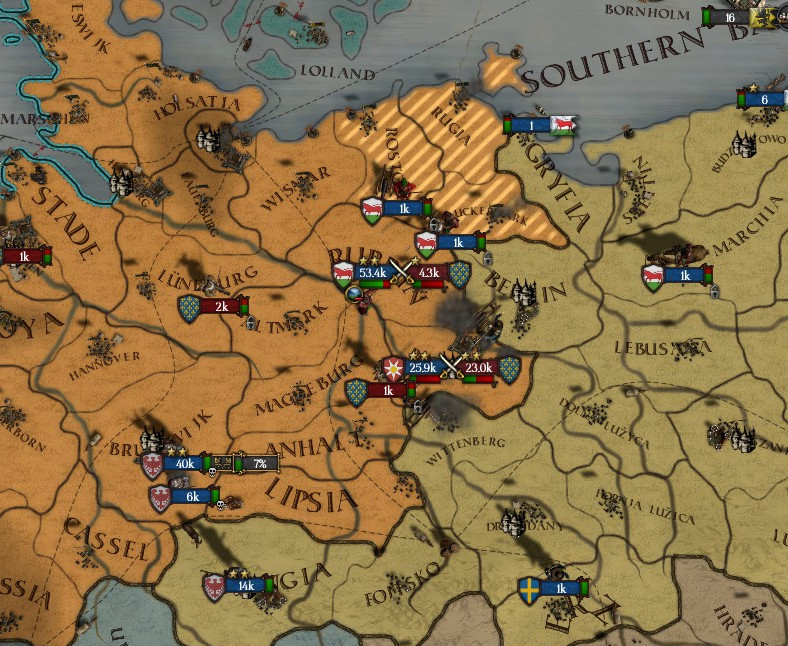 The first major battles of the war came from the eastern Frankish-Sorbian border, as a combined Romanian-Thraco-Sorbian army attacked several key points in the Franks' eastern march. While Brunswijk was taken by the Romanians without contest, the Franks attempted to defend their fortifications around Ruppin.  The Franks failed. By the autumn of 1625, most Frankish lands east of the Weser were either already occupied by the Romanian alliance's troops, or were actively being besieged by the alliance. The Franks as of yet refused to negotiate a surrender, but they needed a miracle to recover from the setbacks of the spring and summer of 1625. 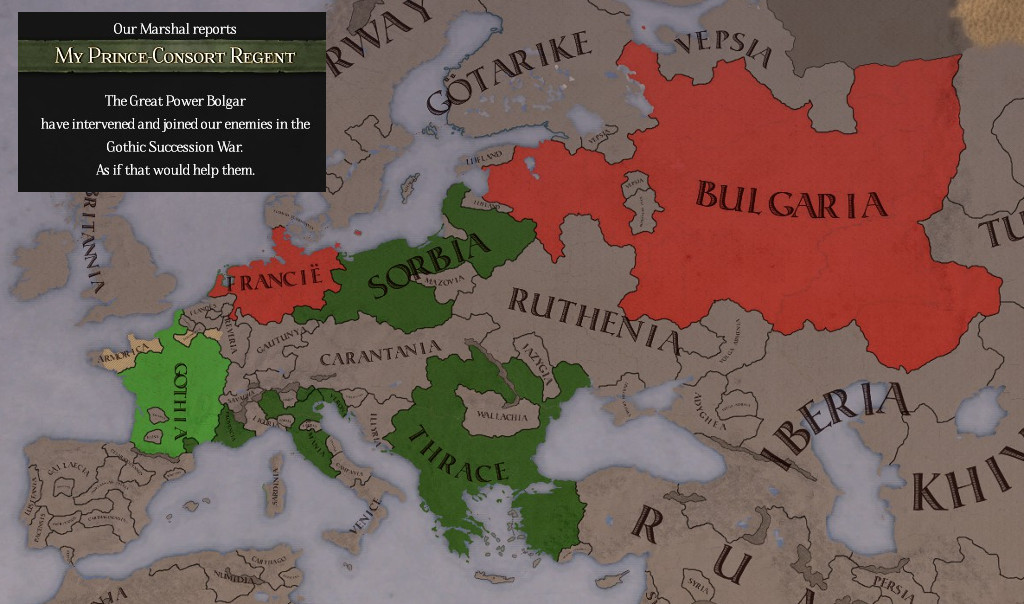 In November of 1625, the Franks got their miracle. The Kingdom of Bulgaria had been anxiously watching the growing power of the Romanian-Thracian alliance for decades, and had coveted much of Sorbia for just as long. With the alliance preoccupied with the Franks, the Bulgarians decided to seize the opportunity and strike Sorbia. 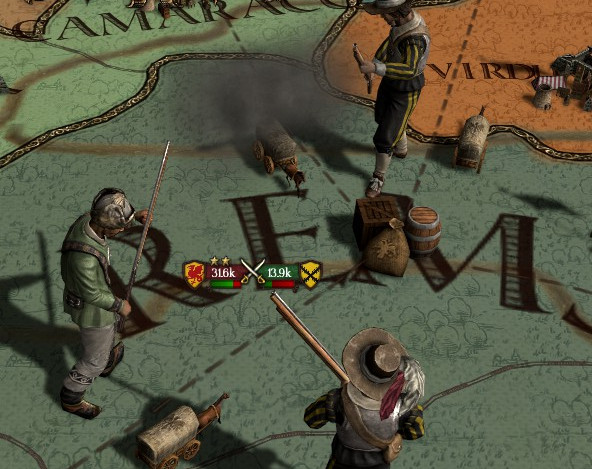 Gothic troops thus far had played a marginal role in the war. All of the imperial realms between Gothia proper and Francië either bore a grudge against Gothia- as was the case with Flandés- or were alarmed by the growing power of Romania, and refused to allow Gothic troops access through their territories. Unable to assist in the attack on Francië, the Gothic army had not maintained a high level of alertness, and was caught completely off-guard when a Bulgarian force led by Vakrim Aygi marched straight into Gothia late in 1626. 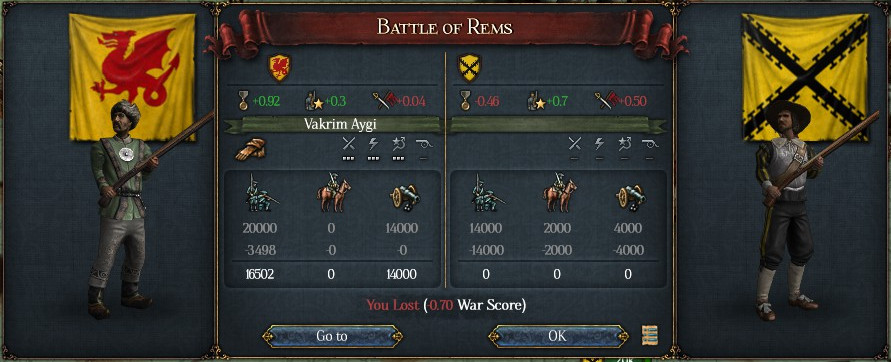 The First Battle of Rems on the 9th of September was an utter disaster for the Goths. Leaderless (Irmanric Botas, the general in charge, had been recalled to the capital some weeks prior), Gothic morale had been disastrously low, and the Bulgarians' vast superiority in artillery had weakened the Gothic army further. As a result, the entire Armada Raïal was destroyed by General Aygi's daring attack. 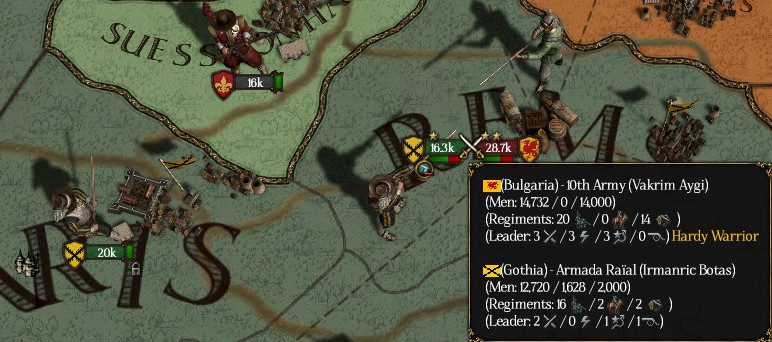 Irmanric Botas immediately rallied Gothia's remaining forces in the area and sallied forth from the capital to re-engage the Bulgarians before they could fully recover. General Botas' main army marched north from the capital, but half the available forces had been on seaside garrison duty and had to march from the western provinces, leaving Botas' forces divided when he first engaged General Aygi and the Bulgarians again at Rems. 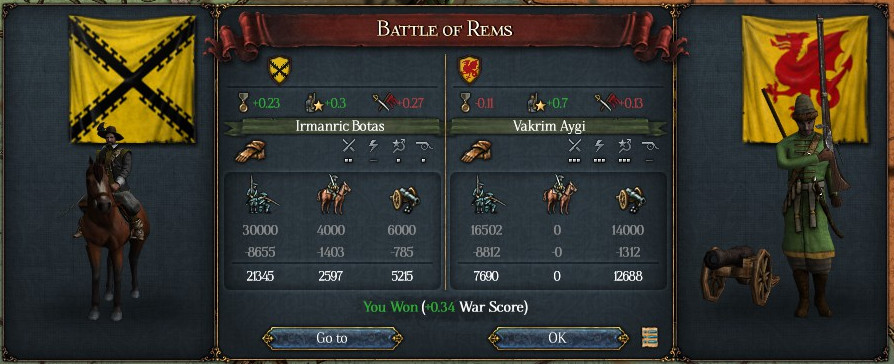 The western reinforcements arrived at the last moment, giving the Goths the support they needed to overcome the Bulgarians' withering artillery fire. This time, it was General Botas and Gothia who won the Battle of Rems. 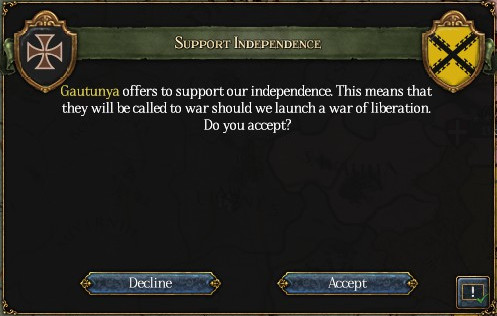 With this gesture of renewed vitality, the Goths received a surprising message from the Western Roman Emperor, promising to support any Gothic effort to regain its independence. Although some Gothic nobles were pleased by the gesture, there was neither the widespread enthusiasm for a revolt nor a good opportunity- the Romanians and Thracians together still outnumbered any possible alliance the Goths could put together- to break away from Romania. 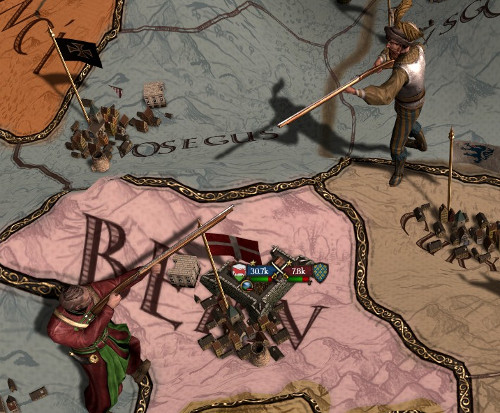 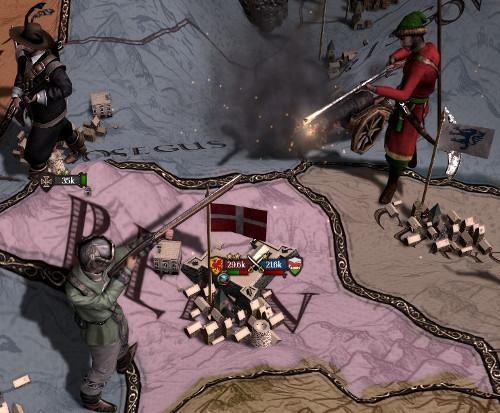 Following Vakrim Aygi's march on Gothia, more battles began between the frontiers of Gothia and Francië. Opposing armies clashed twice near neutral Bern late in 1626- the First Battle of Bern, on October 31st, resulted in a Romanian-Thracian-(Sorbian) victory, but the tired Allied troops were soon attacked by General Aygi's Bulgarian army and defeated just a few weeks later. 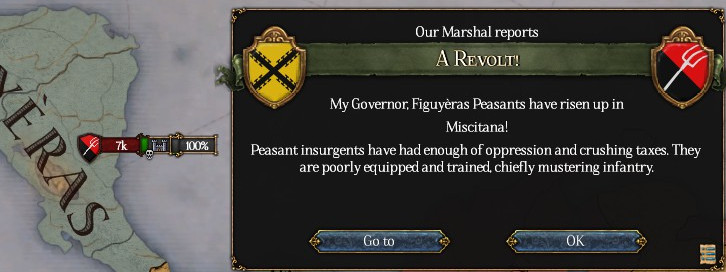 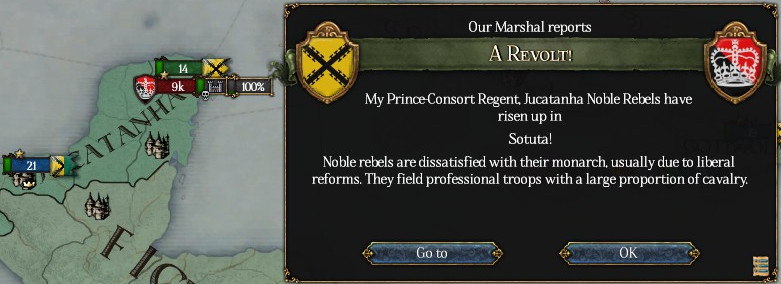 The demands of the War of Gothic Succession were felt not just in Gothia proper, but also in the Gothic colonies. The need to rebuild the army and fully fund larger standing armies caused Gothia to increase its financial demands on its colonies, prompting new taxes and reactions from both the upper and lower sections of Colonial Gothic society. 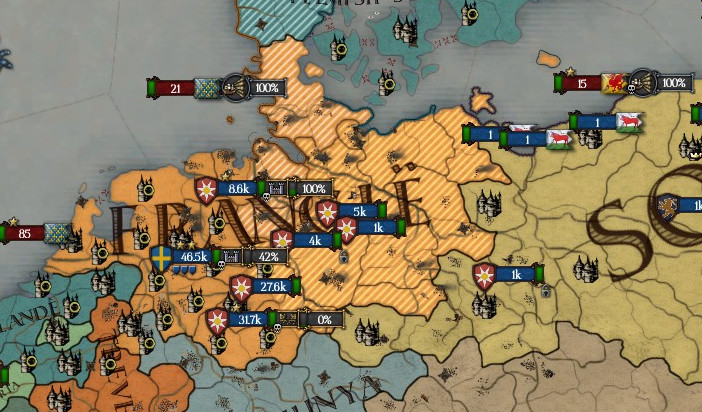 Increased taxes and expanding the military paid off for Gothia and Romania. After experiencing losses following Bulgaria's entry in the war, Romania and Thracia regained the initiative by 1628, re-occupying large portions of Francië that had been abandoned in 1626 in the face of Bulgarian offensives. 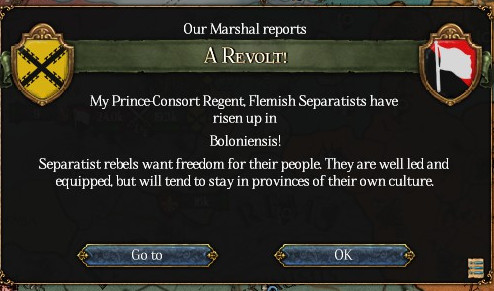 Even though the war was decidedly in Romania and Gothia's favor, the allies' realms were beginning to feel the strain. Central Italy erupted in revolt in July of 1628, and the Flemish provinces of Gothia rebelled late in October of 1628. Although both revolts were suppressed quickly, they were clear signs of war-weariness in the populace. 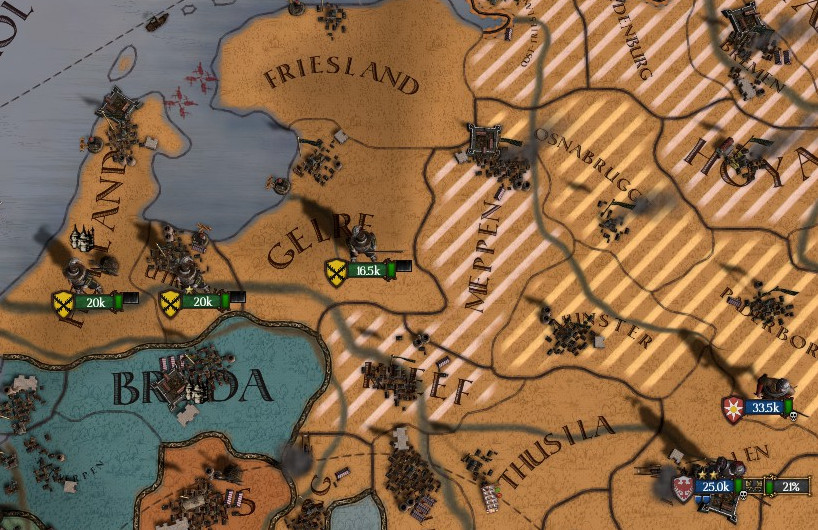 The Franks were faring even worse, and their resistance completely collapsed in early 1629. The Goths finally reached an agreement with Flandés for military access, and sent troops across the Low Countries to assist attacks on the Franks' last strongholds in the Netherlands. Francië's own capital was even occupied by Thracian troops by the summer of that year.  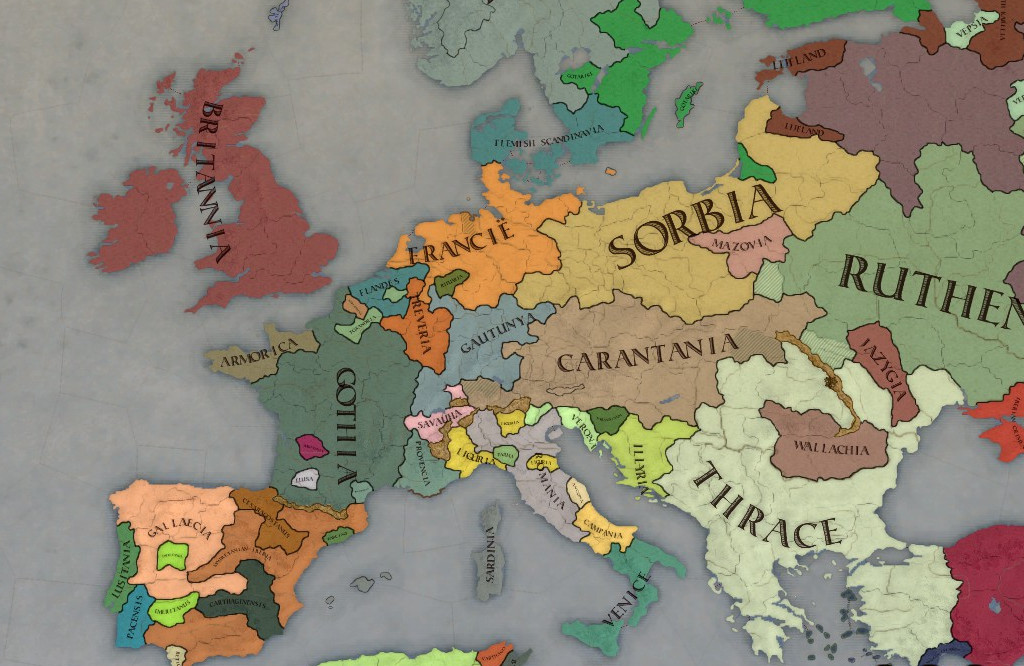 Thus on September 18th, 1629, Francië surrendered to the Romanian-Thracian-Gothic alliance, acknowledging Romania's claim to the Gothic crown and renouncing its own claim to Gothia. The Thracian-Sorbian union, in recognition of its help in the war, was awarded a great stretch of eastern Frankish territory, and the Frankish crown was forced to pay Romania and its allies a considerable sum of gold. 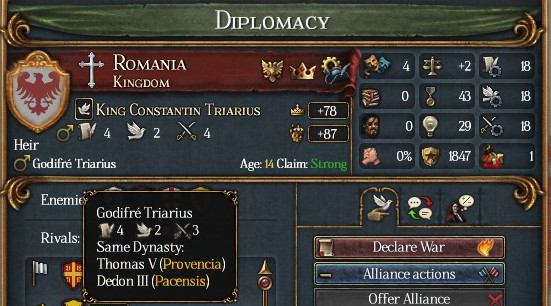 And so Constantin Triarius, King of Romania, formally became the uncontested King of Gothia. Although an adroit administrator and military mind, as the recent Gothic War of Succession had shown, King Constantin was a poor diplomat. His son and heir, Godifré, likewise lacked diplomatic skill. While this was no issue in their home country, in Gothia it proved to be a festering problem. 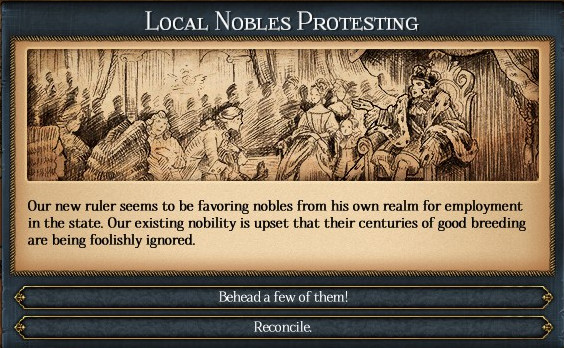 After the end of the War of Gothic Succession, King Constantin brought many Romanian advisers with him on his first peacetime visit to the Gothic capital. When Constantin left to return to the Romanian capital of Papia, his advisers remained behind to assist in the administration of Gothia. Gothia's centuries of imperial government had left it with a homegrown bureaucratic class, however, which now found itself marginalized by Constantin's new Romanian officials. For the time being, most either retired to country estates or fruitlessly attempted to find positions for themselves in the new regime, but there were also a few outspoken nobles who directly criticized the government- and those paid dearly for their words.  Exacerbating Gothic irritations about autonomy under Romanian rule was the contrast with Romania's attitude towards the Gothic colonies. While King Constantin left Gothia under the rule of Romanian officials, Gothic colonial officials were barely disturbed by the change in regime, and in some cases were scarcely dealt with at all by Romania. This effectively gave the Gothic colonies a free hand to act as they saw fit, a freedom which was used by some colonies to rapidly expand and cement their control over natives that Gothia had previously tried to cultivate cordial relationships with. The benign neglect of Gothia's colonies and the scuttling of old Gothic colonial policies by Romania would prove to be another mark against the new regime by the old Gothic nobility. 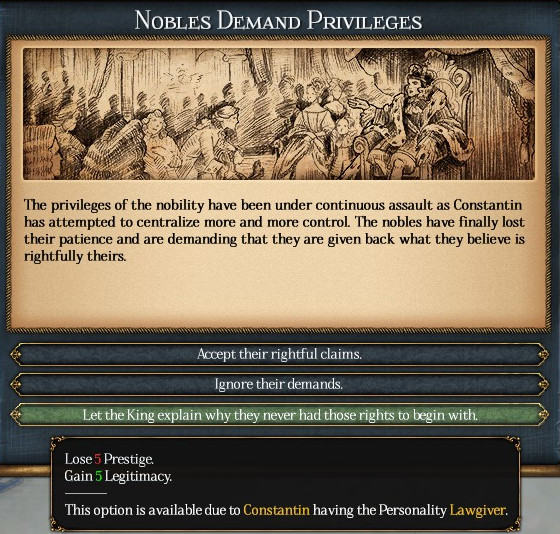 The discontented nobles as of yet had no clear leader or spokesman to rally around, seriously handicapping their efforts to restore Gothic autonomy or independence. When a noble delegation approached King Constantin in 1632 with a list of grievances, the king was able to run circles around them, citing old breviaries and medieval laws to justify every one of his government's actions in Gothia, and concluded by airily dismissing all the nobles' complaints. 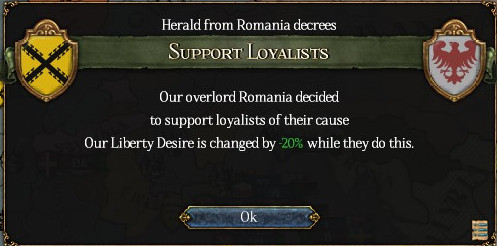 King Constantin's confidence in situations such as the 1632 confrontation belied a fear of Gothic resurgence and awareness of the fragility of the personal union. While the king publicly acted brash and self-assured, in countless private royal councils he worked to strengthen support for Romania within Gothia. One surviving document from 1633 revealed a secret subsidy that Constantin provided to regime-friendly nobles in central Gothia, while another file from 1634 proved that some pro-Triarian pamphlets from the era were actually paid for directly by the Romanian crown. 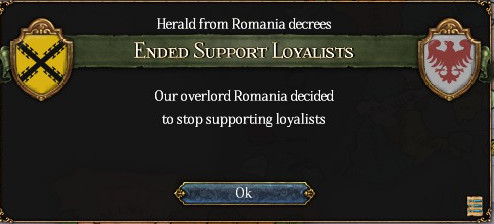 The subsidy program seems to have not fared well, as there is no documented evidence for it after 1635. It is not entirely clear why it ended, although several noble families that received payments later ended up in revolt against the crown, suggesting that the deeper schemes were being prepared by the Goths even at this early stage. 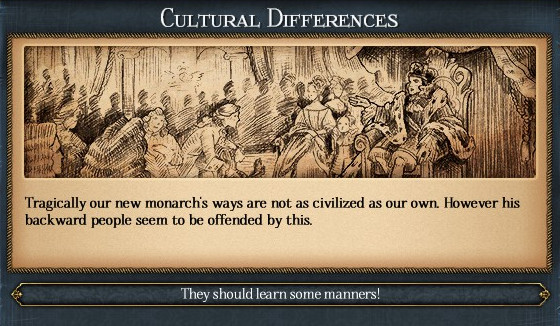 Other efforts to strengthen Romanian-Gothic bonds backfired even more spectacularly. Another crown visit to Gothia in 1633 sought to frame the union as the first step in a “Restoration of Rome”, including a renovation of Liyun's old Roman arena and the staging of pseudo-gladitorial combat for the “Prince of the Romans”, Constantin Triarius. King Constantin, however, did not appreciate the attempt at Romanity- a pious man, he considered the mock “bloodsports” blasphemous (several animals died, but all the “gladiators” eschewed killing their opponents), and objected to being called “prince” instead of “king”. He never set foot in the rebuilt arena, and left the Gothic capital as insulted by his subjects as his subjects were by him.  Perhaps the one area where Gothia truly flourished during King Constantin's reign was in the East Indies. There, in the middle of a New Guinean estuary, the first Gothic outpost in the East Indies was established in 1633. Although Kerema was little more than a few rain-soaked shacks at first, it persevered, and became the first in a string of bases around the coast of New Guinea. 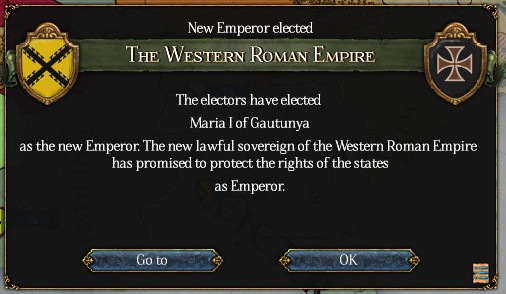 Another blow to Romanian prestige came in September of 1635, when the electors of the Western Roman Empire hailed Duchess Maria of Gothonia as their new empress. King Constantin had expected to win that election in a landslide, but not one elector ended up casting a vote for him. All the crown's propaganda about 'Rebuilding Rome' now felt very hollow, both in Gothia and in Romania itself. 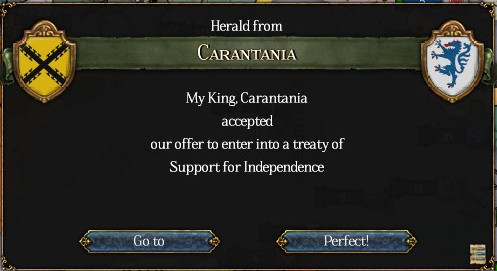 Gothic dissatisfaction with Romanian ballooned after the embarrassment of the 1635 Imperial election. A faction of nobles began actively courting foreign governments for potential support in a war of independence, and rumors began spreading of foreign officers appearing among Gothic trained bands and noblemen's retinues. 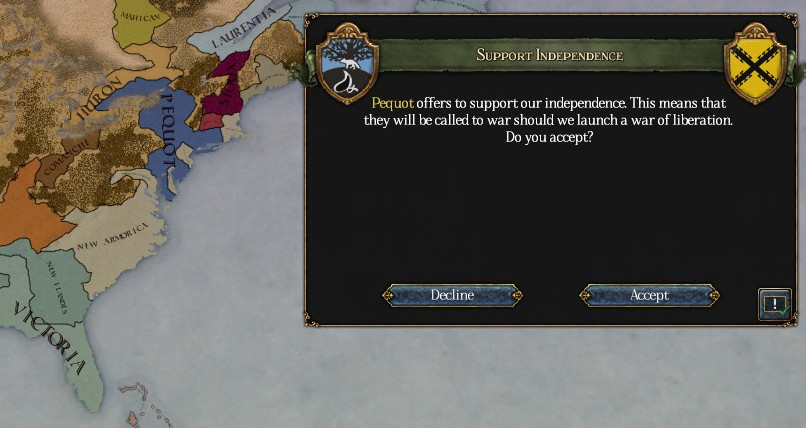 Not all support for the Goths came from Europe. The Pequots of northeastern North America were very keen to see Gothia independent and powerful in the Americas again, as they had been engaged in a series of frontier wars with Gothia's old colonial rivals, the Armoricans. Although they had thus far been victorious over the Armoricans, even annexing a few of their colonies, the Pequots anxiously sought new allies nevertheless. 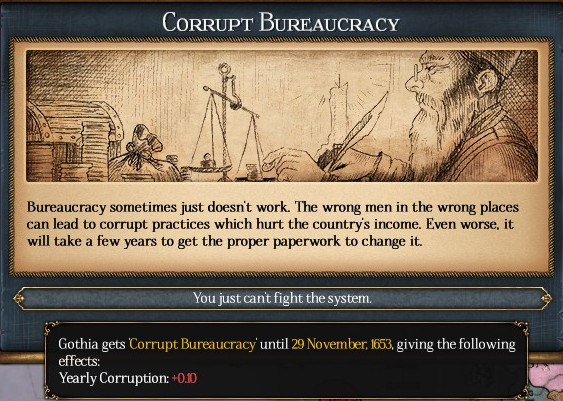 Popular support for independence only really blossomed in the 1640s, as Constantin's Romanian officials began indulging in more and more acts of corruption. Some level of nepotism and minor corruption was always to be expected, but scandals in the early 1640s revealed a coin debasement scheme within the Romanian-administered treasury and a scheme to dismantle the Gothic East India Company and replace it with a Romanian equivalent run from Italy. Although neither plot reached fruition, they became yet more marks against the Romanian union. 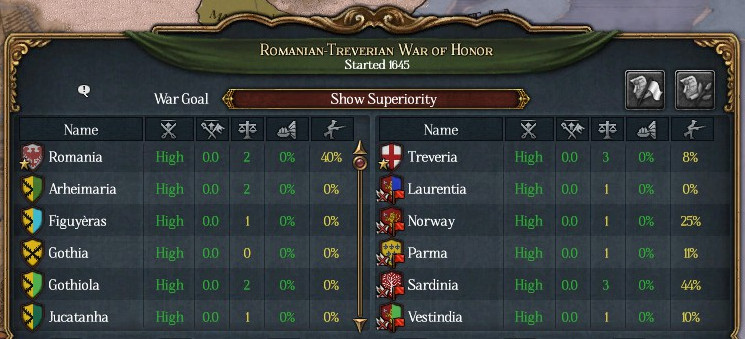 It was in this period of mounting dissatisfaction with the Romanian government that King Constantin decided to attack one of Gothia's old rivals, the Duchy of Treveria. The King was not explicit about his aims, but since Treveria bordered Gothia and the King seemed to recognize popular Gothic sentiment with his war declaration, it was hoped that Gothia might get a strip of land from Treveria if it won. 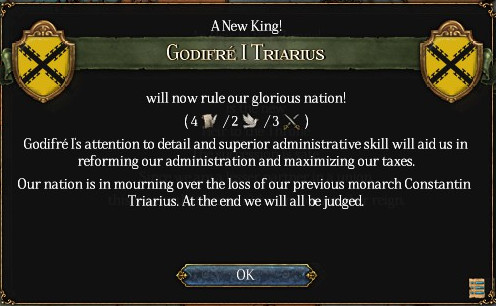 Although the Goths hoped for one outcome, no one actually knows what Constantin intended to demand if and when he won, as he succumbed to a virulent strain of influenza on November 15th, 1645, leaving the crowns of Romania and Gothia to his 30-year-old son, Godifré. 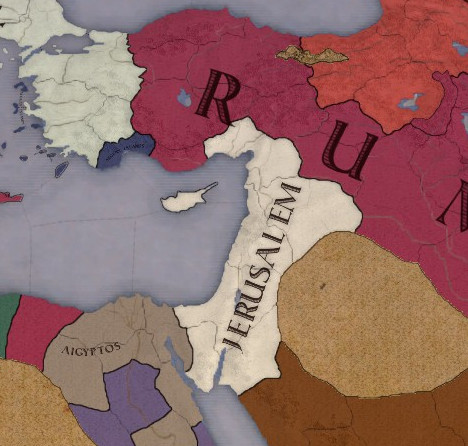 While plots for Gothic independence and Roman revivals fumbled, other efforts at restoration saw more success. To the east, the Principality of Syria won extensive territories in Cilicia from Rum in 1643, including the old holy city of Antioch. With Antioch in Syrian hands, all the major cities of old Jerusalem were back in the hands of one prince, and there, in the city's old Cathedral, Prince Bogdan Sturdza had himself crowned King Bogdan of Jerusalem on March 6th, 1642. World map, 1645: 
|
|
|
|
update when
|
|
|
|
Dumnezeu este cu noi
|
|
|
|
i'm glad that carthage is finally being destroyed
|
|
|
|
So where is the pope in this LP again?
|
|
|
|
I'm glad to see this LP is still going on.
|
|
|
|
ThatBasqueGuy posted:So where is the pope in this LP again? fled to venice and then catholicism went extinct QuoProQuid fucked around with this message at 23:03 on Oct 6, 2017 |
|
|
|
Raserys posted:update when
|
|
|
|
We taught the Franks and their savage masters what it is to defy Gothia, and now we must do the same with these Romanian pretenders! They bind our enterprise, mock our traditions, and allow our colonial achievements to fester and waste! These Triarii may rule in Italy, but there is no Roman steel in them! The electors saw it, and now we must prove it, and find a new king to lead us back to our rightful glory! Hear this, Godifre! We will break our shackles, and then we will break you, for daring to put them on us! We will drive out your agents and destroy your armies, and then we will build our Rome on the ruins of your petty kingdom!
|
|
|
|
Who's the light green-yellow country that owns Taiwan and a bunch of other islands in the Pacific?
|
|
|
|
HailedUser posted:Who's the light green-yellow country that owns Taiwan and a bunch of other islands in the Pacific? Croatia
|
|
|
|
Ghost of Mussolini posted:Croatia You say that, but I think it's actually Tarnate. You know, that weird Pacific state that always colonize everything in the near Pacific by the start of the 1700s.
|
|
|
|
So does Councilism allow for monks?
|
|
|
|
Chapter 59: Freedom 1645-1653  Gothia's union under the kingdom of Romania had just plunged it into war against one of its old neighbors, Treveria. The king of Romania (and Gothia), Constantin Triarius, declared war on the Treverian realm just days before his death, leaving Gothia, Romania and the course of the war in the hands of his son, Godifré.  Constantin had been a capable ruler, but his death had come suddenly, and Godifré had not been able to confer with his father in the days prior to the king's death. Godifré thus came into a war unsure of its purpose and not confident in his control over either Romania or Gothia. 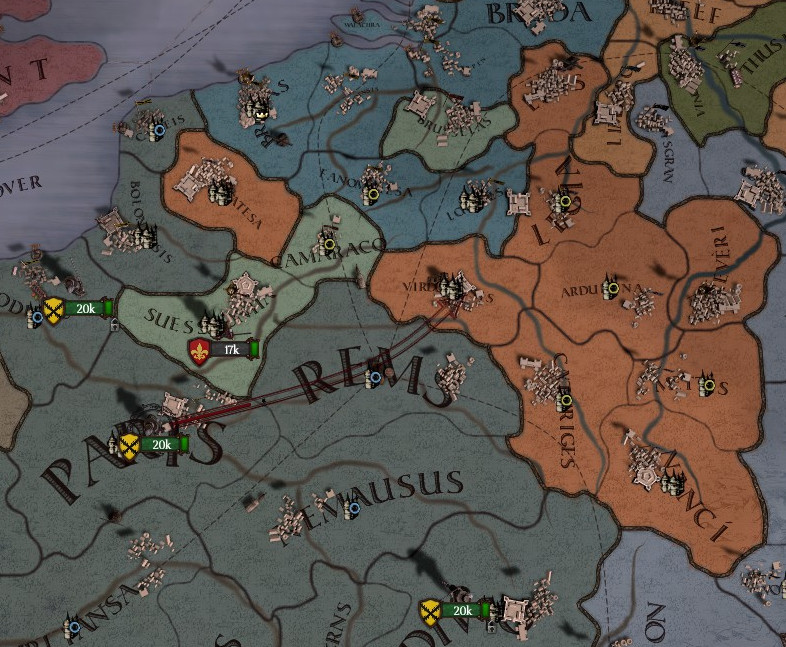 The Goths at least knew what they wanted: Treveria's western border provinces were heavily fortified and very prosperous, and the Goths wanted them for their realm. King Constantin, although prone to certain missteps in his relation with Gothia, had tried to curry favor with it, and the realm had entered the war with the expectation that Constantin would reward it for its service to the Romanian crown. King Godifré was not aware of these expectations. 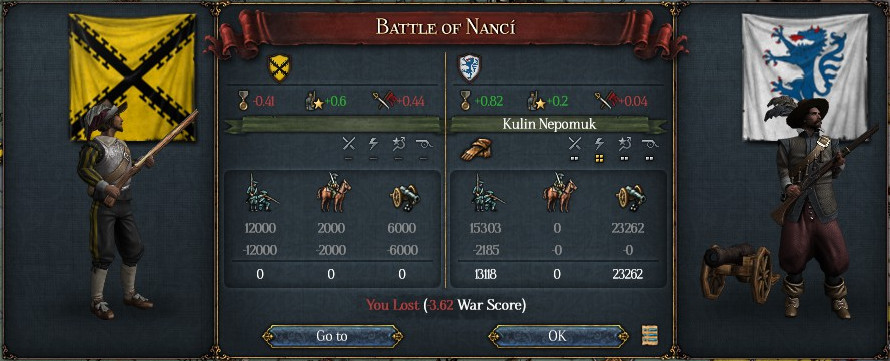 Gothic participation in the war fared poorly. Treveria had been allied with mighty Carantania, a realm which spanned from the Alps to the Carpathanians, and together, Treverian and Carantanian troops easily defeated Gothic armies in several battles in late 1645 and early 1645. The Battle of Nancí, on March 31st, 1646, was a particular humiliation for the Goths, as a Carantanian force managed to completely destroy the Gothic army which had been besieging the coveted city. 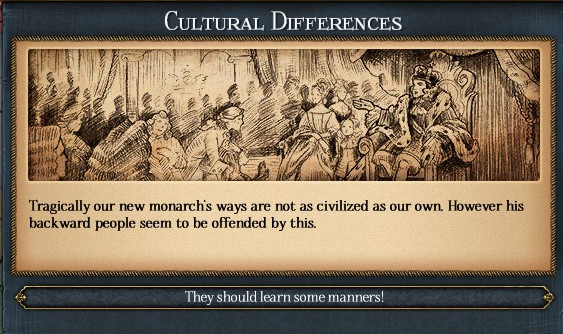 Adding insult to injury, King Godifré received news of Nancí while at a ball, and flippantly quipped that Goths were no equal the Romanian troops who were winning battle after battle at the same time in the Alps. 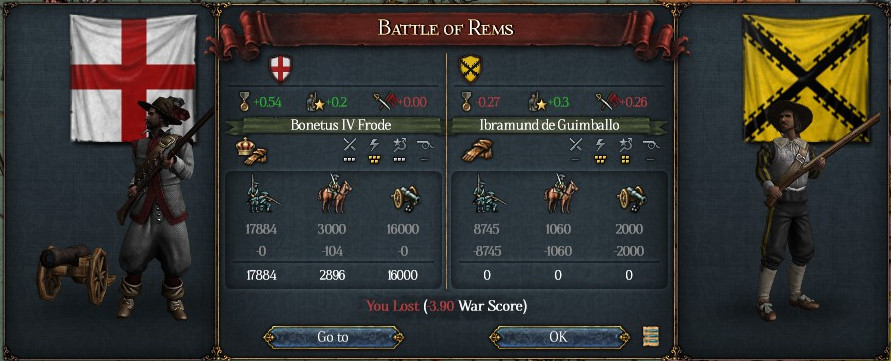 Two weeks after Nancí, another Gothic army was destroyed near Rems. Gothic morale was rapidly collapsing. 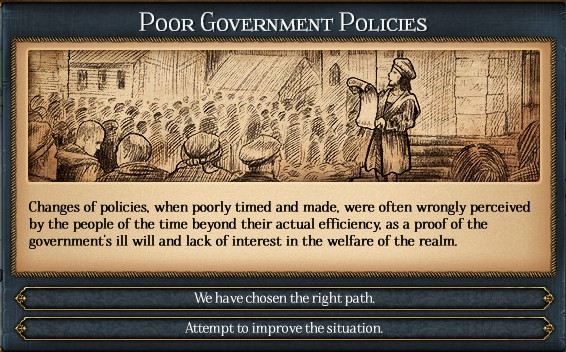 Romania's attempt to support Gothia at this time backfired spectacularly. Seeking to inspire a sense of common struggle, King Godifré tried to import some of the austere traditions of the Romanian Reformed faith into Conciliarist Gothia. The classic stone altar used in the cathedral of Liyun was replaced with a wooden communion table at the king's behest, and a simplified liturgy was implemented in several major cities across the realm. These reforms did not go over well among the Goths. 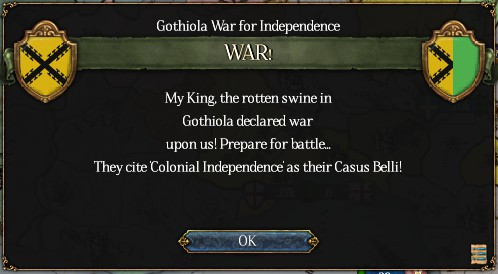 At this nadir in Gothic fortunes, on August 28th, 1646, the Caribbean colony of Gothiola revolted against Gothic rule. Puelle Balthes-Cabironis, the governess of the colony, was driven from Petropolis by a mob led by Amalric Hardus. Hardus then sent men out to seize the rest of Cuba in a general rising, and proclaimed the whole of Gothiola independent, “freed from the sinking Gothic ship”. 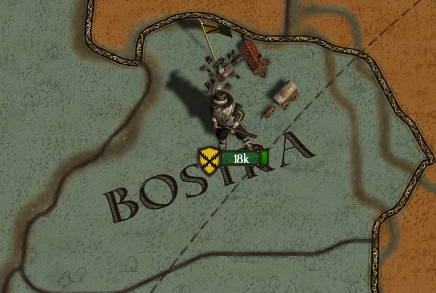 Most of Gothia's troops were committed to the war against Treveria on its own eastern border, but there was one frontier army doing garrison duty near the confluence of the Mississippi and Ohio Rivers, which was immediately ordered south in the hopes that it could then get conveyed to the rebellious Caribbean islands. 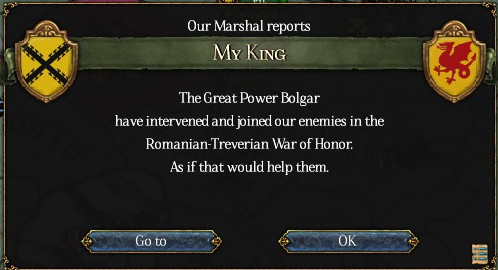 Even that token effort was stretching Gothia's resources, as the war in Europe escalated with the intervention of Bulgaria on the side of Treveria and its allies. 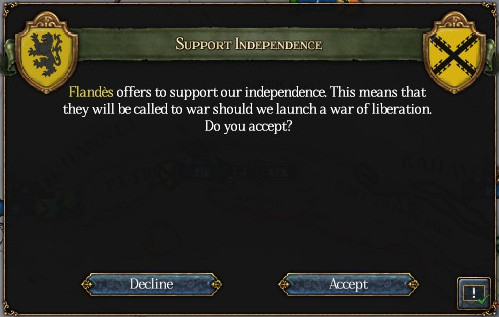 While the sharp decline in Gothic fortunes was seen by some as a opportunity to dogpile on the country, others saw Gothic instability and weakness as an opportunity to support and use Gothia directly for their own ends. Flandès, which had not so long ago lost a few provinces to Gothia, now took the opportunity to offer the Goths help in their struggle for independence. This way, the Flemish court reasoned, the Goths would be encouraged to be a nuisance to the Romanians, so both realms would be too preoccupied with each other to prey on Flemish lands. Years earlier, Gothia's traditional elites would have turned down such an offer, but now, with Romanian control of government leading the country into disaster, and with the old Gothic ruling classes increasingly sidelined by new Romanian officials, the Goths accepted. 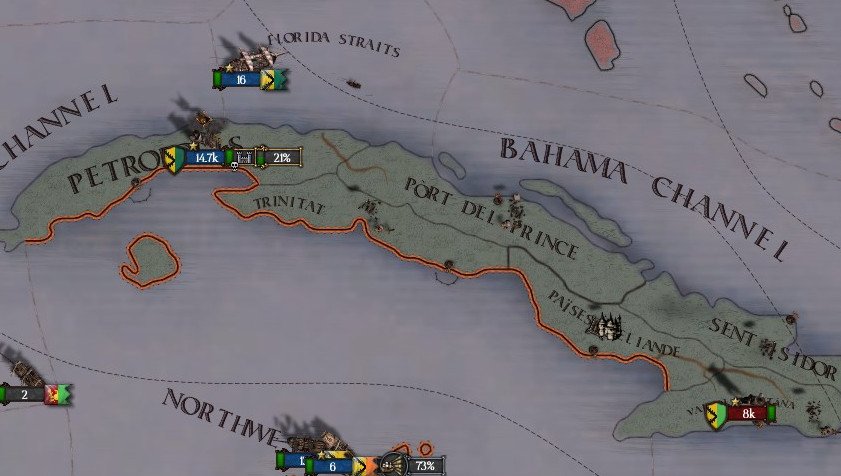 With Gothia preoccupied by the war with Treveria- Gothia's sole colonial army was diverted from Cuba to Gaul to fight in the European theater- the task of subduing Gothiola was increasingly left to Gothia's other colonies to handle. Mounted militia from the Floridian colony of Victoria successfully landed near Petropolis in February of 1647, and invested the colonial town's fortifications. 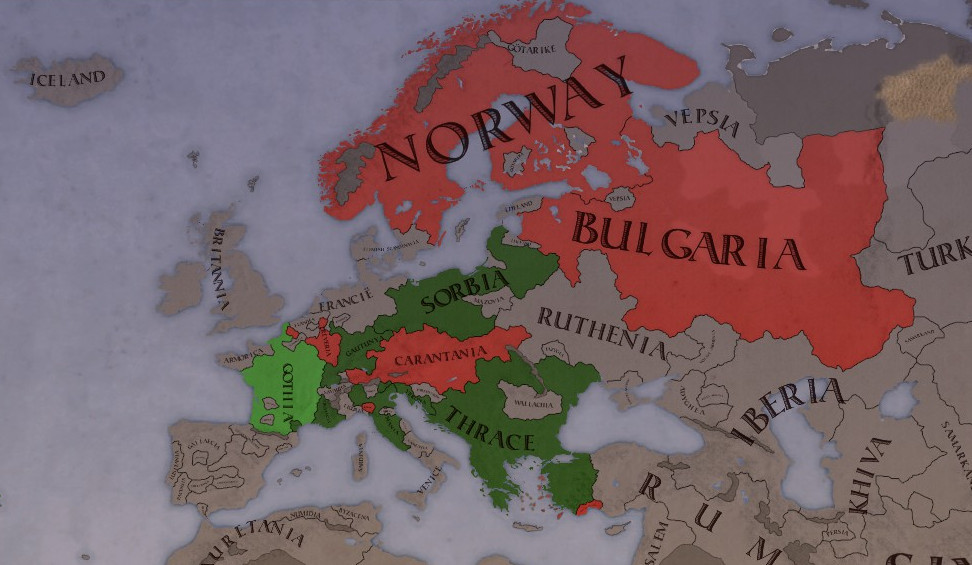 The war had escalated far beyond anything King Godifré, or even his late clever father King Constantin, could have anticipated. Battles were raging across Europe, from the Treverian provinces along the Rhine to the Baltic forts that marked the frontier between Sorbia and Bulgaria.  Doubts about Romanian rule were spreading. Although the old Gothic nobility had harbored anti-Romanian sentiments for some years, by 1649 pamphlets targeted at the city-dwelling burghers and lesser rural gentry were stirring up resentment across a much wider swathe of Gothic society. The Treverian war was having a disastrous effect upon the kingdom, and although progress was being made against Hardus' rebellion in the Caribbean (Petropolis was finally captured on July 5th, 1649), the fact that colonials were largely responsible for those victories was equally humiliating. 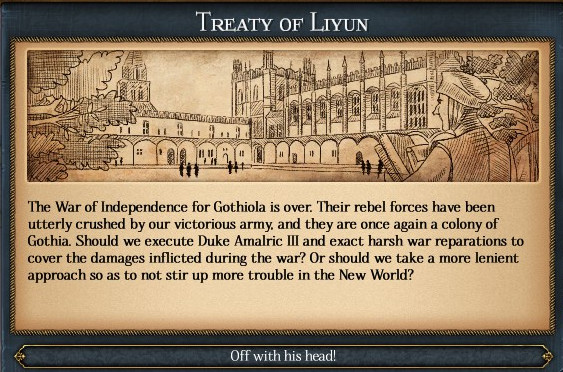 When Amalric Hardus finally surrendered himself to the authorities on January 2nd, 1650, in the midst of this period of growing frustration, anger and fear, the Goths (including representatives from two of the colonies) refused to mollify his followers by showing leniency, and ordered Hardus' execution and the execution of his highest-ranking accomplices. Resentment in Gothiola against Gothia would simmer, but at least the immediate revolt was crushed. 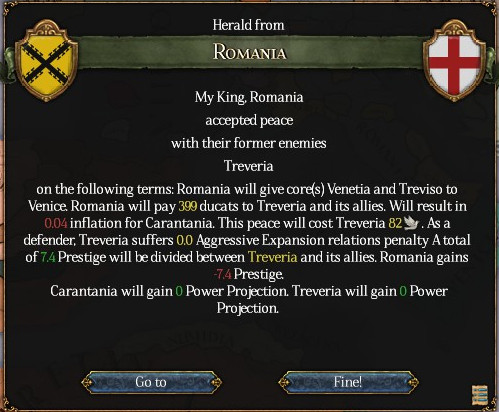 Resentment in Gothia reached a boiling point on March 1st, 1650, when Romania sued for peace with Treveria- and accepted defeat. What was the point of accepting Romanian rule when the Romanians could not even fight a war against a little imperial duchy without it spiraling out of control into a continent-spanning conflict and a humiliating loss?  Even more infuriatingly, King Godifré tried to cover up his humiliation by sparking another war just a month after accepting defeat against Treveria. 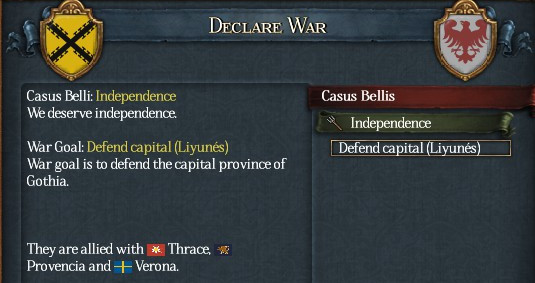 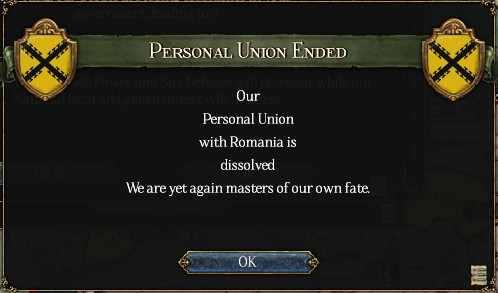 That was too much for the Goths. On October 12th, 1650, Pèitre de Margens, a nobleman from one of the oldest senatorial families in the realm, rode to the old royal palace in the capital with a small company of men, and in front of the main entrance addressed a crowd of agitators, proclaiming the independence of Gothia and the end of the union with Romania. The crowd cheered, and the speaker was soon hailed as King Pèitre IV of Gothia by popular acclamation.  The Pequot indians, who had committed themselves to the Gothic cause years ago, and Flandès both jumped at the call to arms. The Pequots' involvement ended up being largely symbolic, but the Flemish troops would prove to have a real impact on the war. 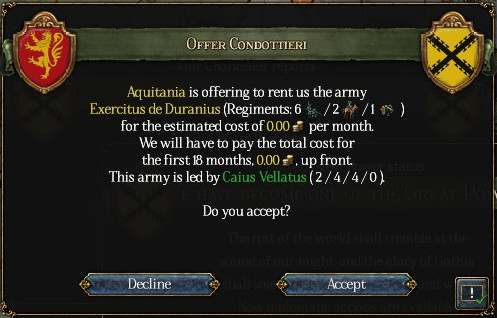 Other countries offered support in a variety of ways as well. Aquitania, notably, offered Gothia the use of its army at no cost to the Gothic coffers. 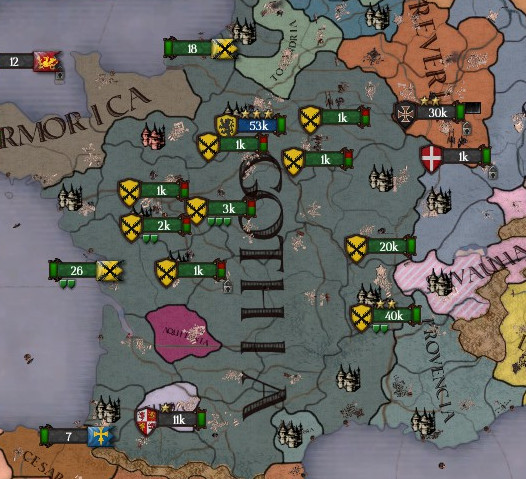 Although Gothia's armies had been shattered by the recent war against Treveria, the realm still had significant reserves of men and materiel. The call to arms was enthusiastically received by the populace at large, and thousands of men managed to be mustered in a matter of months. Their training and morale may not have been the best at first, but being able to just field large army in such a short time proved to be a valuable asset to the Gothic cause. 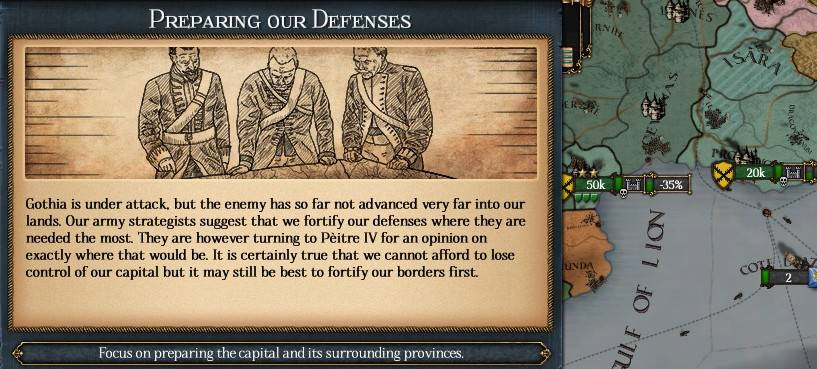 Gothia's declaration of independence had not cut short Romania's war against Liguria in Italy, and the Goths were unsure how their former overlords would react to the declaration of independence. While Gothia began sending out its field armies to attack the territories of Romania's Gallic ally, Provencia, King Pèitre personally directed the reinforcement of fortifications around the capital, in anticipation of a possible counterattack. 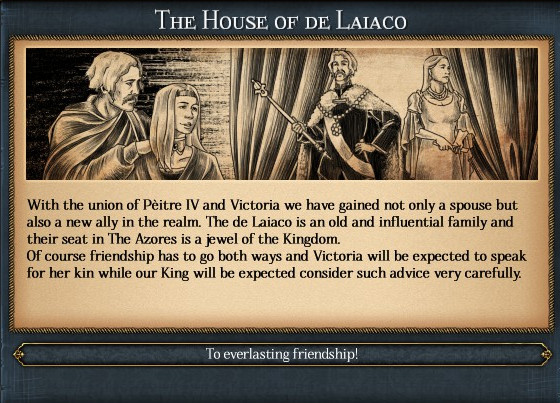 Pèitre also worked to reinforce his own right to rule during these early days of the war, marrying a Gothic noblewoman from the Azores and fathering an heir, Princess Sibilla. The House of Margens was working assiduously to cement its hold over the old Triarian kingdom. 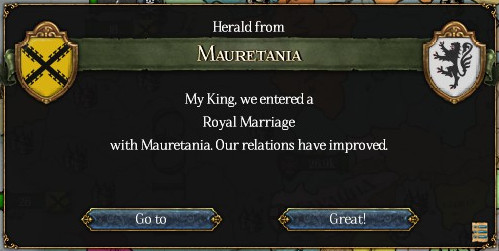 The king also engaged in personal politics with other European realms, seeking to gain more allies and more support even while the war of independence still raged. 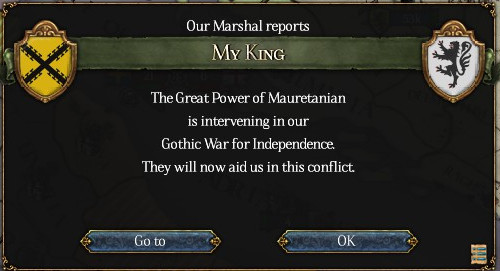 Pèitre's diplomacy paid off handsomely when the Kingdom of Mauretania, the North African kingdom which also ruled half of Spain, married a scion of its ruling family to one of Pèitre de Margens' cousins, establishing a dynastic bond between rebel Gothia and Mauretania. A few months later, in November of 1651, Mauretania moved to protect its new friend, and intervened in the war of independence on behalf of Gothia. 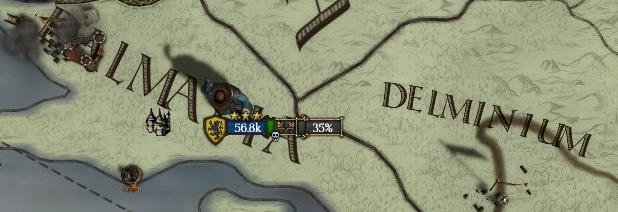 While Gothic and Mauretanian troops made gains in southern Gaul against Romania's allies, Flandés' troops wreaked havoc in the Balkans, raiding the lands of Romania's eastern ally Thrace and compelling Romanian troops to split up between the Gallic theater and the Balkans. 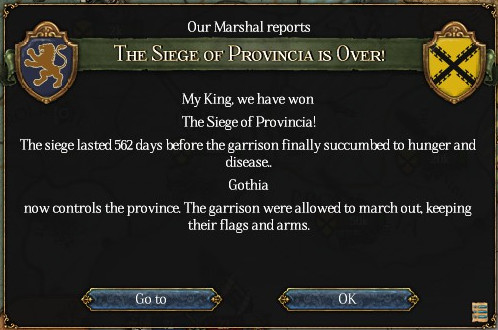 With Romania's focus divided, Gothic troops were able to attack Provencian positions in southern Gaul without contest. By September of 1652, the last of Provencia's major fortifications surrendered to the Goths, and the way into Northern Italy and Romania's home territories opened up. 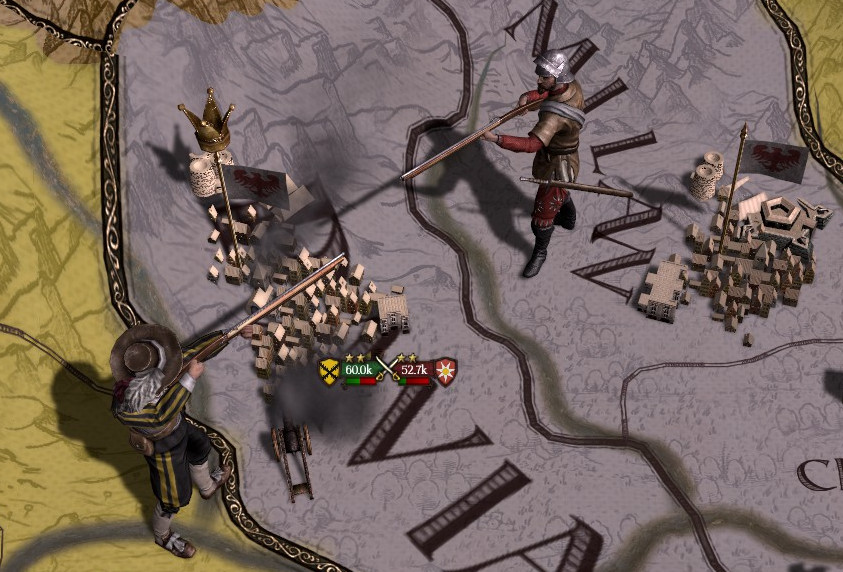 Troops led by the aggressive general Ibramund de Guimballo marched straight to Romania's capital, Pavia, where it met an equally-large force of Thracians, reinforced by Veronese condottieri. 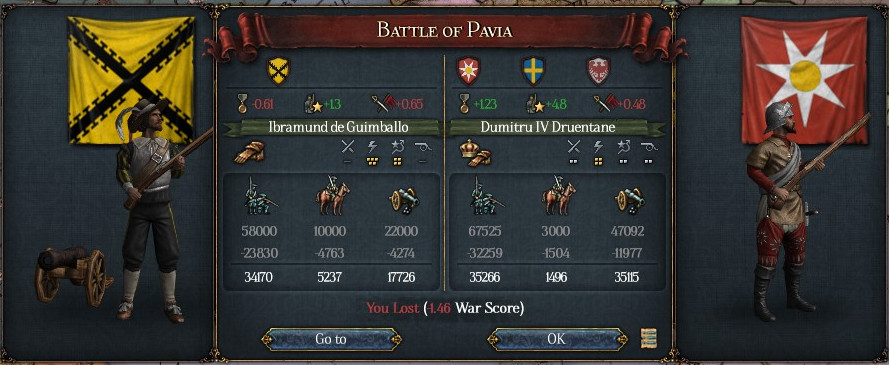 Pavia was a well-fortified capital, and the Thracians used their knowledge of the area to their advantage. Although the battle was close, the Thracians emerged victorious, and so the Goths' foray into Romanian territory was repulsed. But even though the Goths lost the battle, Gothic troops had marched to the walls of Romania's capital, a significant show of strength considering how dire Gothic fortunes had been just a few years prior. 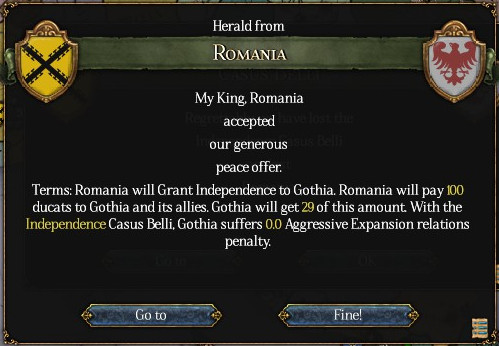 Provencia was fully occupied by Gothia and its allies, Flemish troops were raiding the Balkans, and Romania's war with Liguria was still technically ongoing. King Godifré of Romania looked at the situation, and decided to sue for peace. Negotiations concluded on January 14th, 1653. With that, 18 years of personal union with Romania and 884 years of Triarian rule came to an end, and a new era began for Gothia. World map, Jan. 1653: 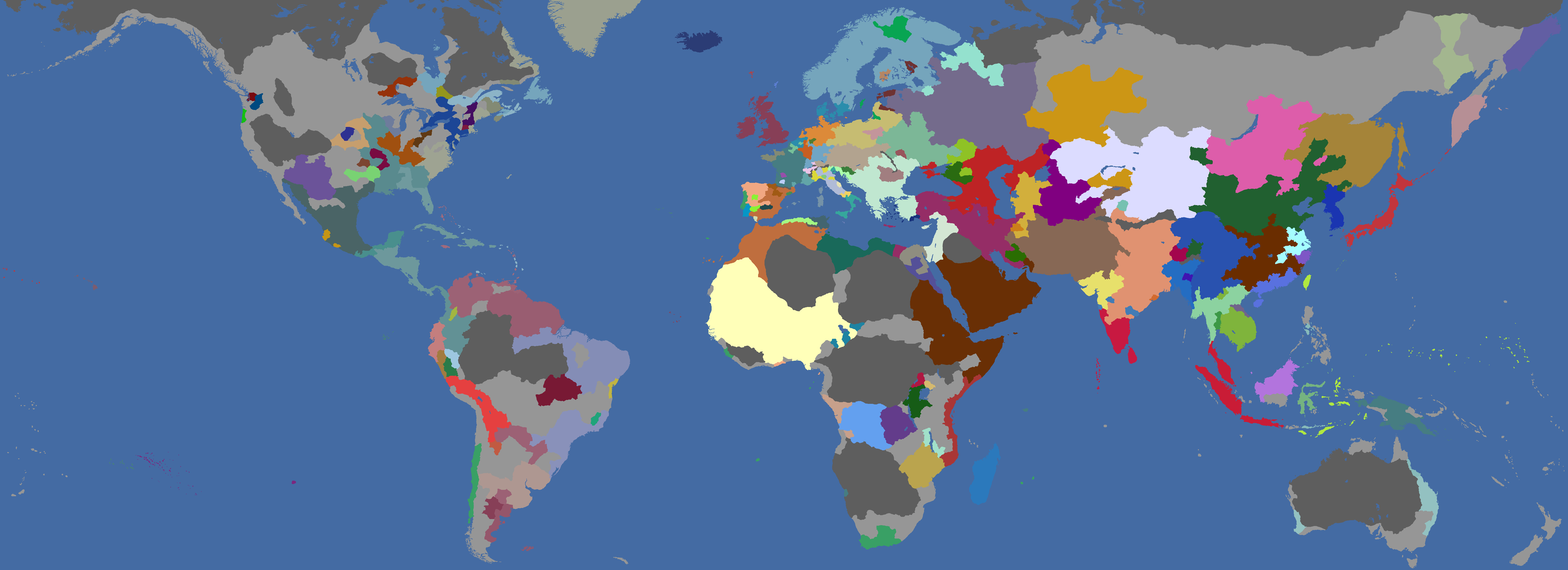
Ofaloaf fucked around with this message at 00:34 on Nov 3, 2017 |
|
|
|
WELL THAT COULD HAVE GONE BETTER. At least we're free of the pointless wars now.
|
|
|
|
Brutus Salad posted:WELL THAT COULD HAVE GONE BETTER. At least we're free of the pointless wars now. At least we can win our colonial wars Is that us in New Guinea?
|
|
|
|
It's going a hell of a lot better than Andalus for sure
|
|
|
|
I think we would have to work pretty hard to get to that level.Lord Cyrahzax posted:Is that us in New Guinea? Yes it is. Ikasuhito fucked around with this message at 04:27 on Nov 3, 2017 |
|
|
|

|
| # ? May 25, 2024 17:28 |
|
Lord Cyrahzax posted:Is that us in New Guinea?
|
|
|






























